HOLY LAND: HOW CHURCHES CAN HELP EASE THE HOUSING
RESPONSE TO HELENE’S WRATH | BRIAN HAMILTON REBOOTS | MIDDLE-MARKET SUCCESS

NOVEMBER 2024

HOLY LAND: HOW CHURCHES CAN HELP EASE THE HOUSING
RESPONSE TO HELENE’S WRATH | BRIAN HAMILTON REBOOTS | MIDDLE-MARKET SUCCESS

NOVEMBER 2024
Building NC: Bandwidth’s Raleigh offices score on our roster of the state’s most compelling new structures.



4 UP FRONT
6 POWER LIST
Veteran journalist David Crabtree was appointed to lead PBS NC in 2022. He discusses media bias and interviewing tips.
8 SCENE-SETTERS
Photos from the NC Rural Economic Summit in Greenville.
10 NC TREND
‘Coolest Things Made in NC’ winners; H&M’s eco-friendly NC plant; Mooresville actor inspires a new generation; Belk scion works to preserve farmland; Adding more nurses becomes a priority; Brian Hamilton returns to the grind.
92 PROJECT PLANS
Wilson’s “overnight success’ that has been decades in the making.

A diverse array of firms top the rankings of the state’s fastestgrowing mid-size enterprises.
61 OUR TOWNS
Even natives of Winston-Salem and Saxapahaw find the Tar Heel towns worth visiting for their welcoming, exciting environments.
74 ROUNDTABLE: WORKFORCE CHALLENGES
Experts discuss key issues facing employers as they encounter a tight, changing labor market.
80 COMMUNITY CLOSE UP: CHATHAM COUNTY















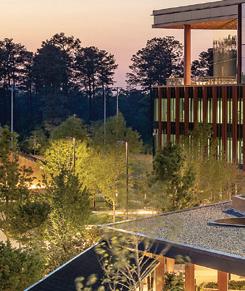


Chatham County’s workforce, shovelready sites and a business-friendly approach place it in the heart of North Carolina commerce. COVER STORY


46













A look at intriguing new and rehabbed structures that opened across the state over the past year.
BY KEVIN ELLIS
A key Asheville employer, a hardhit campground owner and a Boone-area business leader discuss disaster response.



BY KEVIN ELLIS AND NOELLE HARFF




Many N.C. churches are poised to help develop sorely needed affordable housing. But the devil’s in the details.
BY THE REV. JOHN CLEGHORN


Hurricane Helene smacked western North Carolina incredibly hard, causing deaths, unexpectedly severe damage and visuals of raging rivers that seemed unbelievable.
Yet anyone who knows North Carolina realized that the response would be fiercer than anything that Mother Nature could muster. North Carolinians, businesses and nonprofits have raised millions of dollars and facilitated hands-on efforts to support thousands of people affected by the storm. By mid-October, many mountain towns were inviting wary visitors to return, hoping to spur activity in the critical fall tourism season, and some charitable groups said they had sufficient supplies.
The outpouring of aid reflects the incredible pride that residents have in our state, particularly a region with an international appeal because of its natural beauty.
Every emergency forces tough long-term decisions on how to respond, but Helene seems particularly challenging given the storm’s scope and the region’s topography, U.S. Sen. Thom Tillis said in late October. The lack of insurance coverage for most affected residents and rising costs for labor and construction materials also make things particularly complex.
“ You are talking about a disaster area that is the size of Massachusetts, with a couple of dozen areas hit extraordinarily hard and on the brink of not coming back,” Tillis says. “When you have a storm impacting coastal regions, the geography is somewhat prepared for rebuilding. But the mountains are not.”
Thorny engineering problems include repairing Interstate 40 and dealing with creeks and rivers that have shifted channels, the senator notes.
Hurricane Helene and the subsequent Hurricane Milton, which mainly affected Florida, are expected to be the sixth and seventh hurricanes that have created at least
$50 billion in damages in the U.S. over the past seven years, according to the National Oceanic and Atmospheric Administration. Helene’s damage may top $100 billion, most of which will not be borne by insurance companies because so few people buy flood policies, a senior Aon insurance executive told The Associated Press.
Indeed, fewer than 1% of property owners in the 25 counties included in the Hurricane Helene federal disaster declaration have flood insurance coverage, according to the N.C. Insurance Department. Homeowner insurance usually covers damage from wind, but not floods.
“If it rains at your house, you need flood insurance,“ N.C. Insurance Commissioner Mike Causey likes to say. He says coverage “may be quite affordable” in low-risk flood zones, which presumably would include much of the mountain region.
But his efforts to promote more flood insurance purchases since 2018, when Hurricane Florence hit eastern North Carolina very hard, have been ineffective. In addition to the national program, the state’s private option has signed up only one insurer that offers policies.
The record amount of people and structures in the mountains also compounds the disaster’s impact. The population of three of western North Carolina’s most populous counties, Buncombe, Henderson and Watauga, has increased by more than 30% since 2000, adding nearly 115,000 people.
“ You won’t see it depopulate. That part of the state is growing and will continue to grow,” Tillis says. “It’s a beautiful place with a fantastic change of seasons, and that’s why people are moving there.”
“ What will make North Carolina come back is a strong response from our elected officials.”

Contact David Mildenberg at dmildenberg@businessnc.com.

PUBLISHER Ben Kinney bkinney@businessnc.com
EDITOR David Mildenberg dmildenberg@businessnc.com
MANAGING EDITOR Kevin Ellis kellis@businessnc.com
ASSOCIATE EDITOR Ray Gronberg rgronberg@businessnc.com
ASSOCIATE EDITOR Cathy Martin cmartin@businessnc.com
EDITORIAL INTERN
Natalie Bradin
CONTRIBUTING WRITERS
Pete M. Anderson, Dan Barkin, Page Legett, Rick R. Smith, Katherine Snow Smith, the Rev. John Clegharn
CREATIVE DIRECTOR Cathy Swaney cswaney@businessnc.com
GRAPHIC DESIGNER Lauren Ellis
MARKETING COORDINATOR Jennifer Ware jware@businessnc.com
ADVERTISING SALES
ACCOUNT DIRECTOR
Melanie Weaver Lynch, eastern N.C. 919-855-9380 mweaver@businessnc.com
ACCOUNT MANAGER AND AUDIENCE DEVELOPMENT SPECIALIST Scott Leonard, western N.C. 704-996-6426 sleonard@businessnc.com
CIRCULATION: 818-286-3106
EDITORIAL: 704-523-6987
REPRINTS: circulation@businessnc.com
OWNERS
Jack Andrews, Frank Daniels III, David Woronoff, in memoriam Frank Daniels Jr.
PUBLISHED BY Old North State Magazines LLC
PRESIDENT David Woronoff BUSINESSNC.COM




You have had a very successful career in the broadcast world and in other areas. Tell me how you started at WRAL.
I had spent six years in Denver and I was on my way to Philadelphia for a job as an anchor when my agent called and made me aware that Capitol Broadcasting was interested in me.
So I listened to them and on the strength of their reputation and the strength of the ownership of Jim Goodmon, I decided to move to Raleigh, thinking I would be in Raleigh three, maybe four years. That morphed into 28 years as the primary anchor, a reporter, talk show host and just about anything I was asked to do. And it was the best move of my career. The marketplace was very good to me.
David Crabtree was among North Carolina’s best-known journalists when he was appointed to lead PBS NC in April 2022. The Goodlettsville, Tennessee, native decided at age 14 he wanted a broadcasting career. He earned a bachelor’s degree at Middle Tennessee State University. He worked as a government publicist and at stations in Nashville, Greenville, North Carolina, and Denver before joining WRAL, a dominant TV station in eastern North Carolina for decades.
This story includes excerpts from Crabtree’s interview and was edited for clarity.




PBS North Carolina CEO David Crabtree joined High Point University President Nido Qubein in the Power List interview, a partnership for discussion with some of the state’s most influential leaders. Business North Carolina’s annual Power List publication spotlights the state’s powerbrokers.
C-suite people, middle managers, entrepreneurs and business owners are often called on to give a speech or to be on television. What are the two or three pieces of advice you would give them?
No. 1, be open. That means to answer the question that you’ve been asked. If you feel it’s the wrong question or if you feel that question could be better framed, it’s OK to stop the interviewer and say, “I really appreciate that question, but to get at the essence of what you’re looking for, here’s the way I might frame that.”
The interviewer may not have the same tools and vernacular that you have. They may have just asked the wrong question. Don’t overexplain, but give them an answer and don’t dodge a question.
Even if the interviewer uses the wrong word, don’t put yourself in a position to give an answer along the lines of, “It depends on what the definition of is, is.”
Is appearance important for interviews?
If you’re on television, don’t give the viewer a reason to be distracted. You may wear something that your wife or your partner says is awfully boring. That’s OK, you don’t want to be flashy. If you give a viewer anything that distracts them, they will not hear what you just said, and then become disinterested and maybe leave the conversation.
And always look at the interviewer. Don’t worry about the camera, the camera will follow you.
More and more, people care a lot about why should I bring a family here or why should I have a job here or locate my workforce here. What would you tell those people considering coming to North Carolina and the economic impact that could be created here?
For those who are looking to expand, we want them to know what is here beyond basketball, beyond the legacy of tobacco, beyond barbecue or beyond what North Carolina has traditionally been associated with.
This is a state with great pockets of education and great healthcare, and a population that wants to learn and is eager to do better than the generation before them.
And no matter what side of the political aisle you may find yourself, there are people who are serving in this state who truly care about the future of North Carolina and the region.
We don’t have a border around this state to say we don’t want others coming here. We are open and saying, bring us your ideas, bring us your interest, bring us your new way of thinking. We will find a way for all of this to meld and become better.
And by the way, Mr. Businessman, you may be a catalyst for parts of the state that remain marginalized and still need growth. You will find workers who will work hard for you, but have had a difficult time finding traction over the past few years. You may be the opportunity that saves a community
I believe we have a legislature and an administration that’s looking to find ways to make it beneficial for you to move here. And we carry those messages through our airwaves, our website and all of our platforms at PBS North Carolina.
Some people feel that the media is very selective in what it covers and is biased. What is your take on this?
I’ve had this question asked during my entire career. If we are having a conversation and we agree with each other, there’s no bias, right? It’s when we disagree, all of a sudden, well, you’re biased about that.
None of us are robots. We each have an opinion about something. Therefore, I would say it’s OK to say I am biased. I have an opinion about something. Then take a couple of steps back and look for your objectivity.
It is what some people call bias. I call it the myth of neutrality. We’re not neutral on things. We look to be objective and hopefully we don’t step so far back that we lose our influence on what we’re trying to say.
Viewers need to be savvy. If you only want to live in an echo chamber, there are ways to do that. Cable outlets provide an echo chamber for anyone.
If you’re looking for real information, listen and watch what is given. Then, if you can, do a little more research on your own.
I was on Capitol Hill three weeks ago visiting with our congressional delegation. Oftentimes I will hear, “You know David, I don’t care for PBS.” There’s a perception of a progressive or liberal bias by PBS.
So I look around the room and see pictures of children and grandchildren. I ask, “what do your children watch?” And I hear them say, “I don’t know what my wife would do without PBS in the morning.”
I cite visiting with the members of the delegation for this reason. To a person, I was humbled when they looked at me and said, “You have always been fair with me and I value the fact that even though you were tough in interviewing with me, you were fair and gave me a platform to answer a question.”
If you provide the space for people to be heard, then they’ll give you a chance and maybe say, “Oh my gosh, I hadn’t thought of it that way. I may still disagree with you on that, but you’ve given me something to think about.”
If we’ve done that, we’ve done our job.
People will tell me sometimes, “We don’t know which side of the aisle you’re on. We don’t know where you stand.”
And I say, “Well, I like that you don’t. And by the way, what difference does it make?”
I am pro-business and I’m pro-compassion for humankind. At the same time I don’t see any reason why the two can’t exist.
The two are interconnected in many, many ways, David. Let’s talk a bit about business leaders who are dealing with all kinds of geopolitical and economic trends. Events demand that a leader stand up and speak in ways that can inspire, inform and involve people. What is your advice to those leaders?
They have to be consistent in their messaging for everyone hearing it, whether you are speaking to a staff of 50 or 500, or if you’re the president of a university, there could be thousands of faculty.
But just like a large television audience, your message is being received by one person at a time. The human nature of that person, particularly if they work within your organization, asks, what does this mean for me?
So you have to have that knowledge, you have to be open, you have to be honest and if you can’t speak to everything at that moment, let people know you are working on this and I just can’t go into detail now.
But when I can, I will be back and we will discuss this.
If you’re called to lead, then what does that mean, versus just managing a process?
Managing is very mechanical. Leading is relational, it’s not just transactional. It means taking risks. It means sharing your vision. It means standing where you believe you have to stand and saying, here’s the direction we’re going.
Prevailing winds can be very deceptive.
Absolutely. They may be strong for the moment and lead you right into the rocks.
Tell us about your experience, early in your career, working for Tennessee’s governor.
I worked for the legislature in Tennessee as press secretary, then I worked for a governor, and I had to testify against that governor in court. He went to prison and died a pauper selling cars. And 900 people came to his funeral.
Are you free to tell us his name?
Ray Blanton. He was elected in 1974 and served one term. I testified in his federal trial in 1981 or 1982. He died in 1996. (Blanton was convicted on charges of mail fraud, conspiracy, and extortion for selling liquor licenses. He had a 22-month prison term.)
As a young man, I saw a lot of things. I saw the underbelly of government. Governing is very hard. Campaigning is not as hard.
You earned a master’s degree in theology at Duke Divinity School in Durham. Why did you do that other than so God could forgive your sins from political science and grammatical errors?
I met the dean of the divinity school while waiting on a flight at the airport in Nashville after my granddaughter was born. He invited me to an event the divinity school was hosting at Sea Island, Georgia.
I realized that there was so much I still wanted to learn about my own faith and my moral compass. Then a good friend of mine who became my mentor at the divinity school, and is now a bishop in England, said “Come to my classroom and give it a try.”
Well, I was hooked.
It took me 10 years taking one course a semester to finish. It was the most transformational time not only for my spiritual core, but in the way I treat people and the way I react with people now in a leadership position. It’s all connected. ■

East Carolina University, Greenville
Oct 1-2, 2024
The inaugural NC Rural Economic Summit brought together business leaders from across the state to continue the conversation about how to build stronger small communities through changes in healthcare, broadband, education and business. 2024 Trailblazers were also announced at the summit.
Photos by Kim Tilghman, ECU Communications

Thank you to our event sponsors:
PRESENTING SPONSORS



PLATINUM SPONSORS



Big ideas from North Carolina’s small towns.

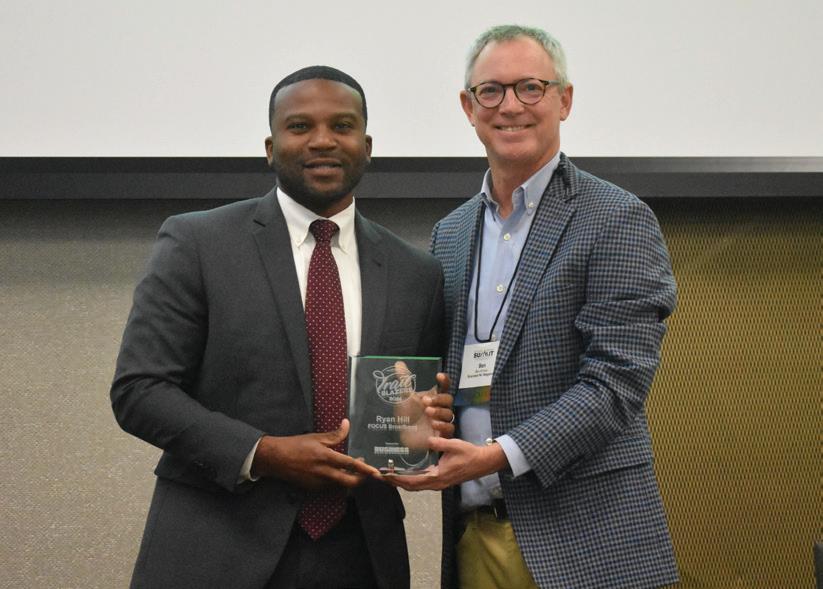



GOLD SPONSORS
























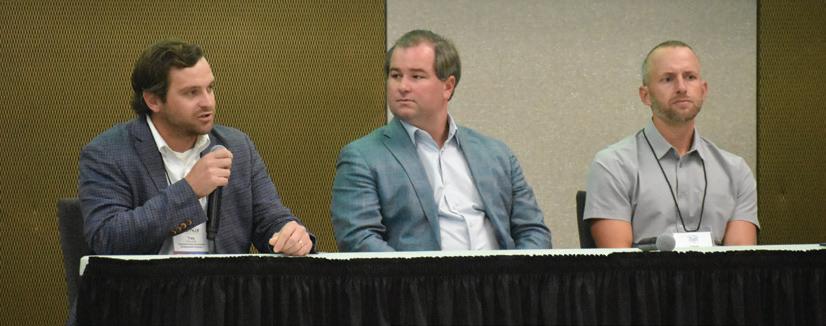

















Piedmont Pennies makes snacks. Honda Aircraft makes jets. They share the ‘Coolest Things’ title.
By Kevin Ellis
One is a crunchy, cheesy snack based on a cherished family recipe. e other can y 11 passengers about 1,780 miles at 422 knots, or 485 miles per hour. e rst is baked in Charlotte, and a large carton of goodies costs about $22. e latter is manufactured in Greensboro, and its price tag tops $7 million.
But the Original Sharp Cheddar Biscuit Bites by Piedmont Pennies and the HondaJet Elite II by Honda Aircra Company can claim similar titles. Both are winners in the h annual Coolest ing Made In North Carolina contest sponsored by the NC Chamber. Piedmont Pennies won in the category for companies with 100 or fewer employees, while Honda Aircra won in the medium-to-large division.
e two companies’ origins di er as much as their products.
Burlington native Becca Wright quietly launched Piedmont Pennies in September 2020 by renting a commercial kitchen in Chapel Hill to sell snacks which grew from her grandmother’s recipe. She started the company a er COVID derailed the UNC Chapel Hill MBA grad’s plans for an internship at Facebook (now Meta) in California.
She moved to Charlotte in December 2020. A $50,000 grant from the NC IDEA nonpro t for entrepreneurs in the fall of 2021 helped propel the brand. She now sells her snacks at more than 400 locations in about 35 states, in addition to online sales. e store launched sales in all Fresh Markets in North Carolina. e company has six employees.
Honda Aircra , a subsidiary of the big Japanese automaker, announced in 2007 plans to make its world headquarters in



Greensboro, a year a er its founding. e company now employs more than 900 workers around the Triad. Cumulative HondaJet deliveries surpassed 250 planes globally in the last scal year.
e HondaJet Elite II is considered the fastest and highestying jet in its class, but it still had to beat out some sti competition to win the “coolest thing” title, says Honda Aircra CEO Hideto Yamasaki.
“Honda is honored to receive this recognition from the people of North Carolina – the birthplace of aviation,” Yamasaki says in a release.
Piedmont Pennies spread credit for its recognition. “ is win really isn’t about our product or our company, while both are amazing, it is about our people. e Penny Partners (retailers) who carry our product and supported our growth, the Penny Pals (loyal customers) who’ve been with us since Pennies was a grad school project, and the Penny Pinchers (teammates) who strive every day to bake quality products so you can spend quality time with those you love. ank you from the bottom of our hearts for voting, supporting and Stayin Cheesin!” the company put on Instagram.
NC Chamber launched the competition in 2020 to honor the state’s manufacturers and raise awareness about careers in the industry. Manufacturing employs about 474,000 workers in North Carolina, more than 10% of the state’s workforce. e industry topped $102 billion in economic output in 2021 and had 17% of the state’s gross product. Illinois-based Baxter, which has its largest plant in North Cove in western North Carolina, sponsored the online competition, which had a record-setting 145 nominations this year. Business North Carolina is the media partner.





Winners in the medium-to-large business category (more than 100 employees):
1ST PLACE: HondaJet Elite II – Honda Aircraft (Greensboro)
2ND PLACE: Roush & Yates Racing Engines –V6 Twin-turbo EcoBoost (Engine for Limited Edition Ford MK IV (Mooresville)
3RD PLACE: Carrier – Centrifugal Chillers (Charlotte)
4TH PLACE: TW Garner Foods – Texas Pete Hot Sauce (Winston-Salem)
5TH PLACE: CSL Seqirus – Flucelva (Holly Springs)
6TH PLACE: Columbia Forest Products – PureBond Formaldehyde-Free Hardwood Plywood (Old Fort)
Winners in the small business category (under 100 employees):
1ST PLACE: Original Sharp Cheddar Biscuit Bites –Piedmont Pennies (Charlotte)
2ND PLACE: Lighthouse Candle Factory – Custom Handmade Candles (Kernersville)
3RD PLACE: Mantissa Scorpion – Sortation System (Charlotte)
4TH PLACE: WoolTribe – Signature Cable Beanie (Charlotte)
5TH PLACE: Atlantic Beach Sea Salt (Atlantic Beach)


2023: C.R. Onsrud: Q-Series 5-Axis CNC Machine, Troutman (medium-to-large); Fjord: Static Rope Edge Protection, Burlington (small)
2022: Caterpillar: 299D3 XE Compact Track Loader, Sanford (medium-to-large); beachBub: All-in-one Umbrella System, Greensboro (small)
2021: Western Star: 49X Vocational Truck, Cleveland
2020: Thomas Built Buses: Saf-T-Liner C2 Jouley Electric School Bus, High Point. ■

Fast fashion leader H&M launches an eco-friendly plant in North Carolina.
By Katherine Snow Smith
H&M Group became a global powerhouse by producing affordable apparel, much of which is discarded after a few appearances. Now, it is opening its first U.S. factory in Mebane based on technology developed in North Carolina that aims to reduce the fashion industry’s detrimental impact on the environment.
The project leader is Syre, a textile company launched in March by H&M and Swedish investment firm Vargas, along with a fund whose backers include environmental activist Bono and Sir Richard Branson. It will make recycled polyester from discarded textiles.
Earlier this year, Syre raised $100 million and acquired Premirr Plastics, which is based in Garner. It was founded by Matthew Parrott and Chris Luft, both former UNC Chapel Hill professors. “Textile-to-textile (recycling) is more rare and we need to build up the infrastructure,” says Karen Leonas, a professor of textile sciences at NC State University. “We are creating a closed-loop manufacturing system which allows for a circular economy.”
Most recycled polyester is made from plastic, with less than 1% coming from used textiles, according to the Textile Exchange, a global nonprofit. An estimated 11.3 million tons of textiles ended up in U.S. landfills in 2018, according to the EPA. That accounted for nearly 8% of all municipal waste.
“We’re trying to intercept polyester destined for the landfill,” says Parrot. “We don’t need to pull nonrenewable resources from the ground to feed the polyester industry.”
Parrot says Syre, which means “oxygen” in Swedish, will use an existing 35,000-square-foot facility in Mebane.
But Syre and H&M are committed to replicating the Mebane facility’s technology in 12 large-scale plants worldwide within 10 years. The first two are slated for Vietnam and either Spain or Portugal, according to a company press release.
Volvo Cars and the INGKA Foundation, an affiliate of Swedish retailer IKEA, are also investing in the project along with TPG Rise, the environmental-oriented fund whose founders include Bono and Branson.
H&M is the second-largest global clothing retailer, operating about 4,400 stores. It reported $22 billion in revenue last year. It has committed to buying $600 million worth of Syre products over the next seven years, according to the company.
H&M and rival Zara, a division of Spain’s Inditex that has about 5,800 stores, and Chinese online retailer Shein are synonymous with the term “fast fashion.” Zara and Shein are not part of the Syre project.
“Fast fashion is a business model for producing new styles and new lines on a quicker basis and producing them at an affordable price,” Leonas says. “We have found the demand for apparel has gone up almost 200% in the past 20 years. … It just doesn’t stay in closets as long.”
H&M and Zara started substantially spreading their stores into the United States in 2000. China’s Shein, which only sells online, launched around 2015.
Traditional brands may refill their sales floors monthly, while fast fashion firms aim to do so weekly, or faster, says Sheng Lu, associate professor of fashion and apparel studies at the University of Delaware. “The impact of selling a large quantity of clothing using environmentally harmful manufacturing and resulting in textile waste is a huge problem,” he says.
While brands such as Ralph Lauren or Michael Kors may sell about 125,000 different designs a year, fast fashion retailers H&M and Zara offer more than 250,000 styles, Lu says. Shein tops that with about 1 million different styles a year.
The fashion industry has a harmful environmental impact that is exacerbated by fast fashion, which offers relatively low prices and plays to Gen Z’s active social media use.
The population born between 1997 and 2012 tends to be savvy about environmental issues and outspoken about human harm to the environment, demographic researchers say. Yet many routinely fill their shopping carts with mounds of fast fashion.
Social media influencers with thousands of followers or more flood TikTok, YouTube and Instagram daily with “haul” videos in which shoppers broadcast their latest purchases emerging from overstuffed H&M shopping bags.
ThredUp’s 2022 Gen Z Fashion Report stated that a third of Gen Z respondents who said they care about sustainability admitted feeling “addicted” to fast fashion. The study also reported 40% of college students looked at fast fashion sites at least once a day.
Wearing different clothes in every photo posted is a social media staple, Leonas says. Those who wear the same shirt or dress can be flagged as “outfit repeaters.” Those in the 16-to-25-year-old age group “don’t tend to buy clothes to last a long time. They buy clothes to express themselves,” she adds.
H&M says it wants to make clothes more sustainable, while continuing to grow rapidly. In 2022, the company said it expected to double revenue by 2030, and pledged that all materials will either be recycled or sourced more sustainably –by then.
The impetus for developing a better process of breaking down polyester molecules stemmed from Parrott’s prior research and patents for delivering chemo medicine through the human body. He is a former assistant professor in UNC’s School of Medicine’s radiology department.
“Obviously, (used clothing) is not a medical application. But that gave me the resources to study a project that has always been nagging at me in the back of my brain.”
He won a research grant in 2014 and teamed up with Luft, who was a research professor in molecular pharmaceutics at UNC’s Eshelman School of Pharmacy.
They founded Premirr Plastics, and in 2016 received seed funding from Laitram Machinery, a Harahan, Louisiana-based stainless-steel fabricator that makes conveyor belt systems for food processors.
574 suppliers at 1,027 factories in Asia, Europe and North America China and Bangladesh are the largest production markets for clothing.
1.4 million people are employed at the supplier factories; 63% are female.
Fewer than 0.2% of workers in factories are migrants.
15 offices employ more than 1,600 staffers to work with suppliers.





“In 2017 we took a hard look ahead and talked to our families and walked away from our professorships,” Parrott says. They leased R&D space in Morrisville, then moved the business to Garner and focused on recycling old clothes.
In 2022, Premirr Plastics was one of eight global recipients of the Fashion Innovators Award awarded by Amsterdam-based Fashion For Good. The four-person company caught the attention of H&M.
The process starts with machines that shred existing clothes and extract zippers and other fasteners. The clothes are then liquified and previous coatings such as stain preventers are filtered.
“Then we build up the polyester molecule, convert it to resin and spin that into yarn,” he says. “We take that all the way to a finished, cut shirt.”
The patented technology bought by Syre can process a 1,000-pound bale of used clothing, which is about the size of a picnic table, into “new” polyester thread in about two hours. The N.C. plant will emit as much as 85% less CO2 than production of oil-based virgin polyester, officials say.
Parrott estimates a handful of other global entities are developing textile-to-textile recycling processes.
“We’re definitely in a race,” he says. “There doesn’t have to be one winner. Obviously, we are all trying to do what’s best for the planet.”■

A Mooresville-based actor inspires a new generation, including her rising-star daughter.
Lacy Camp with her daughter Darby at the 2021 premiere of Netflix’s “Fear Street Part 3: 1666”.



By Page Leggett
ooresville’s Lacy Camp calls herself a “journeyman actor.” In fact, that’s what most actors are. “It’s a very small percentage that get to be a household name,”
Camp says. Only about 2% of actors make it to that level, Backstage magazine noted in an August 2024 story.
Still, since appearing in her first play as Mammy Yokum in “Li’l Abner” at North Mecklenburg High School, the actor’s life was all Camp wanted.
She was focused on her career during those early days; she wasn’t thinking about marriage and kids. “All I wanted was to be an actor,” says Camp, 47. “I thought acting would allow me to travel, experience new things, meet cool people and eat all the good food.”
Soon enough, something happened to broaden her focus and force her to realize she did want more than acting. Marriage and motherhood suddenly seemed important. And motherhood would bring an entirely new dimension to her career.
Camp’s two daughters wanted to act. Her older daughter, Ruthie, ultimately chose other pursuits. But her youngest, Darby, now 17, began making a name for herself before she turned 10. If you don’t know Darby Camp’s name yet, chances are, you will.
Lacy Camp is hardly the first fledgling actor to dream of red carpets, A-list parties, maybe an Oscar. But after graduating from UNC Greensboro with a BFA in acting and directing, Camp chose Birmingham, Alabama, over New York or LA. She had been in a few musicals, but didn’t consider herself a “triple threat.” She wanted to act, and not necessarily sing and dance.
She considered Wilmington, but remembered a mentor’s advice: “Don’t move anywhere until someone pays you to move there.” So, she toured with Birmingham Children’s Theatre and later with Auburn, New York’s Merry-Go-Round Playhouse.
She loved being on the road. The drawback, she says, was that “every May, you’d be out of a job and have to audition again.”
The uncertainty didn’t change her trajectory, though.
“9/11 was a huge wake-up call,” she said. “I was pursuing a career that had no roots. My granny had recently passed away. My brother, who’s just a couple of years older, had just had a baby –the first grandchild in our family for our generation. Suddenly I was an aunt. I began to question how fulfilled I really was.”
She moved home from New York and began teaching at her alma mater, which she calls “the last thing I ever thought I’d do.” In high school, she says, “I used to wonder how fast I could get out of Mecklenburg County.”
Two weeks after 9/11, she met North Meck’s then-assistant basketball coach, Clark Camp. They got engaged on Valentine’s Day and married the following July. “Twenty-two years later, I have no regrets.”
She found a supportive acting community in Mecklenburg County. Through their shared agent, Lu Anne Bernier of Monarch Talent Agency, she met Pat Dortch in 2012. Bernier arranged for the two to carpool from Charlotte to Wilmington to audition for a North Carolina Education Lottery commercial.

They weren’t hired, but they became good friends and took classes together at Charlotte’s since-closed Actor’s Lab. Dortch eventually founded a studio and wrote/directed/starred in a TV pilot, “LIMBO,” in which Camp had a part. He’s also acted in shows such as “McGyver” and “Nashville.”
“I admire him for his ability to teach and inspire – especially teenagers,” Camp says of the writer/director/actor/teacher. “It’s hard to be good at all those things at the same time, but somehow he manages it — along with being an all-star family man for his wife and three kids.”
Camp frequently refers aspiring thespians to Dortch, whom she met after he’d left his first career as a furniture designer, manufacturer and store owner. Camp left her first career, too. Teaching wasn’t a big stretch, though. Her mom taught for 30 years, and her husband has been in education for 25 years.
“I don’t know many actors who don’t have a side hustle,” Dortch says, noting many are naturally entrepreneurial. These “survival jobs” pay the bills between acting gigs.
After Darby’s birth in 2007, Camp departed North Meck to launch the middle school drama program at the Community School at Davidson, where Darby is a senior.
In 2014, Camp was ready to retire from teaching. That coincided with Darby, then 8, landing a role on “Big Little Lies,” the Emmy-winning HBO dark comedy starring Nicole Kidman and Reese Witherspoon. More on that big break later.
Darby began acting as a toddler along with her mom and older sister. But she wasn’t pushed into it; Camp isn’t your stereotypical stage mom.
Darby chose acting. Ruthie, now 19 and a sophomore at UNC Wilmington, preferred basketball over learning lines. She was in a number of commercials, including one for Pennzoil that starred her mom and former Carolina Panthers’ quarterback Cam Newton.
Ruthie’s residual checks funded a family trip to Disney. But the family business wasn’t for her. She couldn’t understand why her mom and sister chose to watch sad movies.
Actors are “a special breed,” Camp says. “We have to maintain our mental health while being vulnerable enough to go to really dark places.”
Striking that balance came naturally to Darby, who landed her first union role, for “Drop Dead Diva,” at just 6. She began getting more work, and mom and daughter enjoyed being on the road – to Atlanta, Austin, Charleston – for as much as two weeks at a time.
“I was having so much fun with Darby,” Camp says. “And I had no idea when I was younger that this would be fulfilling.”
Remember Camp’s rule about not moving until someone pays you to move? When Darby landed a screen test in New York, she had never been on a plane. The flight was paid for by the production company.
Darby auditioned with Chris “Captain America” Evans, but didn’t get the part. Still, she impressed the casting director, who a couple of years later was casting “Big Little Lies.” The studio flew Darby and her mom to LA for the screen test.
Mom and daughter made the most of their 24 hours in Hollywood, going from the iconic Hollywood sign to the stars on

Grauman’s Chinese Theatre’s sidewalk to Ubering from one hot spot to the next with another “theater mom” and her son who were in town for an audition.
“I told Darby, ‘We’re coming back. I just know it,’” Camp says. She was right. Darby landed the role of Reese Witherspoon’s daughter on “Big Little Lies.”
Witherspoon and other Hollywood veterans working with Darby told Camp not to move to California. Mom had been right; one didn’t have to live in New York or LA to work as an actor.
It may have been Darby’s North Carolina roots, aided by her freckles and distinctive curls, that set her apart from other kid actors.
Jean-March Vallée, the now-deceased “Big Little Lies” director, told Camp that the thing he liked about Darby was “that she was just a kid from North Carolina,” Camp says. “He wanted kids in his movies to look like kids in real life.”
In 2019, Hollywood Reporter named Darby a “Top 30 Under 30” actor. Her proud mom says, “I joke that my daughter took my hopes and dreams and then scored the touchdown.”
Camp scored a touchdown of her own when she discovered that family was just as important to her as a career. But she never abandoned the calling she’s felt since high school.
Dortch admires how Camp has built a career and happy family. “Darby has a normal teenage life, in spite of her early success. Lacy has managed all of it with grace.”
Camp helps child actors prepare for auditions and find an agent, although she doesn’t actively market herself, relying instead on word of mouth. She also acts in commercials and community theater.
“I’ve always, always, always stayed focused on pursuing my dream of being a working actor,” she says. “People often give up on or get jaded with the industry. I’ve been fortunate to not have to rely only on my income for survival, which gave me the freedom to pursue my dream.” ■

A retired Charlotte CEO and the state agriculture commissioner aim to preserve fast-dwindling farmland.
By David Mildenberg and Kevin Ellis
reserving farmland may be a concept that everyone can support, but it’s incredibly di cult in fast-growing metropolitan areas like Charlotte.
at’s the mission that former Belk CEO Tim Belk and others are focused on with the Carolinas Farm Fund. Charlotte is the third major market, a er Chicago and Atlanta, to take part in e orts led by e Conservation Fund, an Arlington, Virginia-based preservation nonpro t.
e Carolinas fund seeks to raise $17 million in private funding over 10 years, with a goal of preserving 5,000 farm acres within 75 miles of Charlotte. So far it has raised about $4 million.
“It’s a very innovative program that they’ve tried in other states and it works,” says N.C. Agricultural Commissioner Steve Troxler. e group’s model is to buy property through an agricultural conservation easement, then lease it to a farmer who intends to acquire the land a er several years in business. Because the easement restricts usage to farming in perpetuity, the property value tends to be 40% to 60% lower than if there were no clauses. Farmers can then a ord to buy the land, if they’ve shown an ability to develop a sustainable business, says Aaron Newton, the Carolinas fund program manager. e rst participant in the Charlotte area is DeepRoots CPS Farm owners Cherie and Wisdom Jzar, a couple that grows more than 60 seasonal crops on 7 acres in Mecklenburg County. Now they are expanding to 44 acres in Union County with
$1.4 million of support from the Carolinas Farm Fund.
“One of the biggest hurdles to people who want to farm is getting access to more land, so this helps us tremendously,” says Cherie Jzar. Longtime farmers “are not able to preserve farmland unless they have people who want to farm it,” she says.
e Jzars started as homesteaders about 18 years ago, producing food for their family on as many as ve sites in Mecklenburg County. “We started thinking in 2018, ‘We’re really good at this and we should think about starting a farming business,’” she says. ey closed on their 7-acre farm in December 2021.

Expanding their business will allow them to move beyond selling directly to customers who come to their property or buy at three local farmers markets. One of their ve children, who studied agriculture at North Carolina A&T State University, is working at the farm. She hopes their other children will farm, too.
“We hope ultimately that this will create a pathway for them to create generational wealth,” she says.
Belk is a third-generation member of the famous department store family, which sold their business to a private-equity group in 2015. He and his daughter, Peanut, co-own a 12-acre organic farm, Wild Hope Farm, in Chester, South Carolina, about 40 miles south of Charlotte. He is passionate about the opportunity for farmers to supply a greater portion of vegetables, fruit and proteins to city-dwellers who prefer locally grown food.
“Overcoming the hurdles of farming a larger property is daunting,” Belk says. “But small and midsized farms can be successful, they can pay competitive wages and generate enough cash to stay current. ere will be some one step forward, two steps back, but I de nitely think it is doable.”
As one of the nation’s fastest-growing regions, the Charlotte area is expected to lose 19,400 acres of farmland by 2040 to housing, retail and other developments, according to American Farmland Trust.

But a liated groups in Atlanta and Chicago have built pipelines with about 18 farms conserved in those areas over the past four years. “ e success in Atlanta gives us hope that we can do something similar over time,” Belk says.
Soaring demand for local food and increased concerns about food safety are propelling the conservation movement, Newton says. For more than four decades, only about 2% of U.S. households have been producing food for the rest of our nation. Preserving farmland is a key priority of Troxler, who has held his elected o ce since 2005. “He has had a great track record in helping take agriculture in North Carolina from $50 billion to $111 billion annually,” Belk says. “We’ve got a leader who understands business, and he’s also been a real leader in farmland conservation.”
e N.C. Department of Agriculture has spent $108 million to preserve 36,000 acres of farmland since Troxler took o ce, he says. Last year, farmers submitted 112 applications for preservation funds, totaling $55 million. But Troxler had only $18 million in his budget. To stretch state tax dollars, the state partners with the Carolinas Farm Fund and other nonpro ts.
Troxler was impressed by Deep Roots during a visit. “It was exciting to see young people who have the heart to farm and the passion to farm to get some land at a price they can a ord.” ■



Husband-and-wife Tommy and Vicky Porter started farming on 200 acres of land in Cabarrus County in the mid-1980s. ey expanded to 600 acres, but knew more would be needed to support their three kids and their eventual families, if they chose the farm lifestyle.
ree spouses and 10 grandchildren, later, their “grow the pie” plan is working out.
Advocates of preserving farmland, the Porters decided to sell conservation easements, closing on the rst one in 2013. ey used the money to invest in more land and now have about 1,100 acres south of Mount Pleasant, about 30 miles east of Charlotte.
e family manages 2,000 sows, 400 head of beef cattle and chicken houses for 30,000 pullets and 12,000 layer hens.
“With land prices the way they are, this is a way to grow a farm,” says Vicky Porter of the easements. “ at’s how to make that pie bigger.”
All but about 200 acres are now under easements or have a contract pending. e Porters conserved 367 acres earlier this year with an easement in cooperation with Salisbury-based nonpro t ree Rivers Land Trust, along with state and federal preservation programs.

e easements had to be a family decision, says Tommy Porter. “If Walmart decides in 20 years this farm would be a nice place for a distribution center, they’ll have to say, ‘no,’” he says.
eir three children, ages 35 to 42, have returned to farm work a er holding other jobs. (One of them remains a Concord re ghter.)
e Porters also host weddings and other events at two large venues on the farm.

e Porters describe themselves as a “unicorn family,” saying it’s rare to have all three children engaged in farming. e grandchildren also help out.
A 13-year-old granddaughter can bale hay by herself as long as an adult is also in the eld, says Tommy Porter. e youngest, 2-year-old Knox, spent a recent day with his grandfather, crisscrossing the farm on an ATV to check on di erent equipment. at was always the dream, say the Porters. ■
— Kevin Ellis






Adding more nurses becomes a top priority for state lawmakers.
By Tucker Mitchell
Four years after the COVID pandemic reared its ugly head, the days of perpetual crisis mode are mostly over at North Carolina’s healthcare organizations.
For human resources professionals in medical care, that’s provided a chance to relax just a little, to sit back and take a deep breath.
“It’s been a journey,” says Jeronica Goodwin, chief people officer at Raleigh-based WakeMed. “But I’m glad to say that we’re practically back to pre-pandemic levels of staffing, with vacancy and turnover rates that are well below the national average. The market is normalizing. There’s finally a little relief.”
Good news, but it may not last long. Goodwin and other healthcare execs know another staffing crisis is looming. Healthcare concerns are staring down a labor shortage in the next few decades. North Carolina will be short 17,500 RNs and LPNs within a decade, according to a report this fall by the state departments of Commerce and Health and Human Services. That assumes no major healthcare event, like another pandemic, between now and then.


Industry leaders agree that there’s no single cause for the coming shortage. Issues include education, retention and workplace safety. Nursing schools need to turn out more

graduates, but that means addressing a shortage of instructors. Hospitals and healthcare systems should make workplaces more inviting, which can require more resources.
North Carolina is also affected by its aging population, with the number of adults age 65 and older expected to double by 2040. That group will outnumber children (17 and under) by 2031, a first in North Carolina history, according to state data. More elderly residents means greater need for healthcare services, including nurses.
In response, industry and political leaders are priming the pump to add more nurses. About 12,000 students were enrolled in North Carolina’s 145 nursing education programs through last fall. Later numbers aren’t available.
Those programs churned out 3,634 graduates, including both RNs with four-year or two-year degrees and LPNs. Enrollment increased slightly from the year before, but the graduation total is 1% less than the previous year.
To change that direction, legislative leaders set aside about $546 million in the two-year state budget that runs through mid-2025. There are 45 different programs and initiatives to boost enrollment and graduation of nurses. The vast majority of money is coming from the $1.64 billion federal bonus that North Carolina received when it expanded Medicaid insurance to more lowincome, working-age adults in 2023.
The feds didn’t restrict how the state spends that money, and lawmakers opted for a lot of construction. The biggest piece, about $292 million, is for new buildings and equipment and equipment for healthcare instruction. All but about $25 million is directed to community colleges, including four new nursing education buildings within 70 miles of each other in the western Piedmont counties of Burke, Caldwell, Gaston and Rutherford.

N.C. legislative appropriations aimed at the nursing shortage (2023-25 budget cycle) (Most money came from federal funds)
$60 million for capital improvements and equipment; Gaston College health education center.
$39 million for construction of a health science building; Caldwell Community College.
$30 million for health program capital improvements; Cape Fear Community College.
$30 million for a health science building; Isothermal Community College.
$25 million for a health science building at McDowell Tech Community College.
$21 million for health career center capital improvements; Robeson Community College.
$20 million for Allied Health center; Pamlico Community College.
$15.8 million for capital improvements; UNC Chapel Hill Nursing School.
$15 million for health care capital improvements; Sampson Community College.
$15 million for a health science building; Roanoke-Chowan Community College.
$12.5 million for capital improvements and equipment for nursing school; College of the Albemarle.
$8 million for planning and expansion of health education buildings and related capital improvements; UNC Wilmington.
Source: North Carolina state budget
The community college system is also receiving $55 million to help create new programs or expand existing ones, while the UNC System is getting $40 million for similar reasons. Though smaller in scope, a $7.1 million recurring appropriation to increase pay for nurse educators at UNC System schools is hailed as especially impactful.
Appalachian State University started its graduate-level MSN Educator program because of increasing demand, says Marie Huff, dean of the school’s Beaver School of Health. “But the compensation needs to be attractive, too, or they won’t stay with us to teach.”
Nursing educators often don’t earn as much as peers on the frontline of healthcare. The average gap in North Carolina is a little more than $10,000 per year, according to the Bureau of Labor Statistics.
Some nurses lose as much as $30,000 in annual salary when they move into teaching, says Trish Richardson, president of the 10,000-member N.C. Nurses Association. “That’s really a step in the wrong direction. There are tradeoffs and most understand that nurses (in healthcare settings) will be paid more, but we do need to improve the pay for educators if we’re going to have more nurses.”
The legislative appropriation provides a 4% increase this year and 3% increase next. In certain situations, based on qualifications or long-time disparities, educators may see an additional 15% bump.
The UNC System has set a goal of increasing the number of graduates by 50% in five years.
Hitting that target shouldn’t be a problem if new funds lead to more instructors, says Tammy Haley, the chair of App State’s nursing department. “Every year we know that we have, and other
schools have, qualified students who can’t find a seat,” Haley says. “A lot of that is the faculty question. This will go a long way toward fixing that.”
N.C. Rep. Donny Lambeth, a retired hospital president in Winston-Salem, says the legislature heard the community colleges and the universities “loud and clear. They’ve got students who want to attend, but they don’t have a way to educate them. I think we’ve stepped up there.”
But more is needed. Lambeth says retention must be addressed, and greater marketing would help attract more newcomers to the field. He plans to file a bill creating a “nursing fellow” program at Winston-Salem State University, similar to the N.C. Teaching Fellows program that was formed in 1986 to address a teacher shortage.
The teaching program funds full, or nearly full four-year scholarships at 10 partner campuses (eight public universities, plus Elon and Meredith), for some 400 prospective educators every year. The competitive program has attracted high-caliber students, proponents say.
Back at WakeMed, which employs 4,700 nurses, Goodwin says the focus will remain on sound fundamentals. The Raleigh-based system didn’t take a deep dive into the bonus pool during the pandemic, when competitors were throwing cash around like it was made of used facemasks.
A significant number of nurses who left have returned to WakeMed as their bonus-fueled contracts end, Goodwin says. “I think that speaks well to a culture of safety, of providing adequate resources, of training, basically of just treating people well. That’s pretty simple, but it does tend to bring people back.” ■














by Jenny Boyer and Matt Thompson




Changing tax laws, political uncertainty, and the whole family at Thanksgiving can take us on a roller coaster ride of ups and downs. But savvy business owners (and their estate planning counsel) know that –in the end – current circumstances provide the opportunity for savvy wealth-transfer planning.
The federal estate tax exemption is still at historically high levels, allowing an individual to transfer up to $13,990,000 in 2025 (through transfers made during life or at death) without estate or gift tax. The exemption amount, however, is set to be reduced by approximately half in 2026.
Meanwhile, markets have been volatile (albeit mostly rising) and interest rates have begun to come back down.
These circumstances have inspired a new round of estate planning for those focused on efficient wealth transfer. Some of those planning techniques include:
Many wealthy individuals recognize the "use it or lose it" nature of the current gift and estate exemption and are choosing to make large gifts before exemption amounts go back down. The utility of these gifts can be maximized by gifting assets likely to appreciate over time or subject to
valuation discounts. These gifts often are made in trust for asset protection purposes and to achieve additional tax benefits.
A grantor retained annuity trust ("GRAT") is a special kind of irrevocable trust. The person who creates and funds the trust – the "grantor" – retains the right to an annuity payment from the trust for a period of years. At the end of the term, the remaining trust property passes to other beneficiaries (such as the grantor's children) either outright or in further trust. Assuming the grantor survives the term, those remaining trust assets are removed from the grantor's taxable estate.
However, unlike a traditional gift of cash or gift in trust (which could trigger gift tax on the entire amount contributed), only the value of the remainder interest in the GRAT is considered a gift. Because there is no precise way to assess the value of the remainder interest at the beginning of the trust term, the government simply assigns a present value based on interest rates in effect at the time of the transfer.
By setting the annuity payment at a sufficiently high level, the remainder interest can even effectively




Senior family members may also consider lending assets at a "frozen" value to junior family members at the appropriate AFR.



To pass muster, intrafamily loan payment terms must be honored as if the loan were between unrelated parties. If the assets appreciate in value significantly over the course of the intrafamily loan, then the return in excess of the "hurdle rate" benefits the junior family member borrower and is outside the senior family member lender's taxable estate.
Ward and Smith's trust and estates attorneys work with business owners, family offices, and financial advisors throughout North Carolina to structure complex taxefficient estate plans. Let us know if we can assist. ■
have a "zero" value, thus using little or none of the grantor's gift and estate tax exemption to affect the gift. These "zeroed-out" GRATs are especially appropriate for individuals who have already exhausted their lifetime gift tax credits and are already maximizing their annual exclusion gifts.
If the GRAT assets outperform the original interest rate over time (which is easier to do as rates decline), there is a windfall for the beneficiaries of the trust.
Closely-held business owners might consider completing an installment sale of discounted business interests to an irrevocable grantor trust in exchange for a promissory note. The note should employ the proper applicable federal rates ("AFR") depending on the repayment term. The trust can be designed as a separate entity for federal estate and gift tax purposes while still allowing for trust income to be taxed to the grantor for income tax purposes (thus increasing growth within the trust).
Post-sale appreciation in the value of transferred assets can pass to the trust beneficiaries outside the grantor's taxable estate free of federal estate or gift tax.





Jennifer V.Boyer
Trusts and Estates Attorney jvboyer@wardandsmith.com
Matthew W. Thompson
North Carolina Board Certified Specialist in Estate Planning and Probate Law mwt@wardandsmith.com
Read additional articles in our new series "Family Matters" throughout November at wardandsmith.com

This article is not intended to give, and should not be relied upon for, legal advice in any particular circumstance or fact situation. No action should be taken in reliance upon the information contained in this article without obtaining the advice of an attorney.



By Rick R. Smith

Brian Hamilton left the business world to help inmates return to society. But he’s turned his attention back to building a company.




rian Hamilton, the Raleigh entrepreneur known for selling a nancial technology rm to high-pro le private equity rm Accel-KKR in 2018, is back in the daily grind.
Asked if he’s satis ed with being back in an executive role at a larger company a er being successful as an entrepreneur, Hamilton chuckles. “Depends on which day,” he says. “It’s tough but rewarding.” How tough? Hamilton, 61, won’t say if Raleigh-based video technology provider LiveSwitch is pro table.
But he says it’s doing well and points out that he isn’t raising money. In 2021, he led a nearly $16 million round when acquiring the company, which was then called Frozen Mountain because it was based in sometimes chilly Vancouver, British Columbia. Hamilton changed the name because, “I like it better,” he says.
Hamilton is the board chair and chief nancial o cer. e company’s founders, brothers Jerod and Anton Venema, are still involved. Both are engineering graduates from NC State University, where they did initial research for their business.
“Jerod was one of the rst people in video and an early leader in the space – a true innovator. I am very fortunate he has stayed on and is running all new product ventures,” Hamilton says. “Eventually, I will take a back seat. I do not think now is the time for this – we still have signi cant challenges to overcome.”
priority is “Inmates into Entrepreneurs,” the nonpro t he started with the Rev. Robert Harris, a Baptist pastor in Oxford in Granville County, in 1992. He remains a director.
“I’m still involved with that. I do teaching as well. But, I guess, at root, I like creating stu so I jumped in again. I decided to do something new around early 2021. I called a bunch of people from my last company and, miraculously, had takers. I guess I missed building something.”

LiveSwitch’s CEO is Michael Adams, a 2016 graduate of UNC Chapel Hill who worked for Hamilton’s personal foundation before moving to LiveSwitch. He also had previously worked for a Washington, D.C., public relations company. “Michael Adams is an incredibly gi ed guy,” Hamilton says. “He will drive the company in the future, not me.”
Hamilton says he wants his colleagues at LiveSwitch to learn from the “around 10,000 mistakes that I have made as an entrepreneur.” Tech giant Adobe is among the companies that have started using LiveSwitch technology.
“We can do better and will. But building a company is incredibly hard. I forgot how hard it is. Some days, I wonder why I did it.”
His mission remains to deliver “Entrepreneurship for Everyone,” as he once proclaimed from billboards around the Triangle. Another
Hamilton, who is not married and has two sons, grew up in Milford, Connecticut. He says his desire to make money came a er feeling ashamed about depending on food stamps early in his life. His rst business, a landscaping company, helped pay for his education at Sacred Heart University in Fair eld, Connecticut. His leadership qualities became apparent when he was chosen student government president there. He later earned an MBA at Duke. While teaching continuing education classes at Duke, he met Sarah Tourville, then a student with so ware engineering expertise. Together they hatched Sageworks, he says, with Tourville serving as “tech guru.” ey launched the company in 1998, early in the Internet age.
Hamilton spent 19 years building up Sageworks, which was a pioneer in using arti cial intelligence to help investors better understand nancial data.
He sold the business to Menlo Park, California-based AccelKKR for an undisclosed price, then focused on the “Inmates to Entrepreneurs” program, which has helped hundreds of prison inmates develop small businesses.
In 2021, the Carlyle Group private equity rm invested in Austin, Texas-based Abrigo, which was then valued at more than $1 billion. Many corporate leaders, including CEO Jay Blandford, are based in Raleigh and work at the former Sageworks headquarters site. Hamilton hired Blandford as president in 2016, and he became Abrigo’s CEO in 2022.
Hamilton laughs about his CFO title. “My last company, Sageworks (now Abrigo), was started as a nancial platform. I guess I know nance,” he says. “I am not a big believer in titles and don’t pay attention to that stu at all. We all pitch in and do.”
Why did you decide to invest in LiveSwitch?
Despite the advancement of technology, I wonder how it has made our human experience better. On the whole, I would say it has not. Are people today happier than they were 100 years ago? If not, technology, as one major factor, has failed us. Why develop stu if it does not make people more ful lled? Speci cally, technology like video can be used to bring people together if deployed the right way. I am excited by how to leverage video, in particular. We have an excellent platform.
What sets its technology apart from other streaming platforms?
I do not believe technology ever on its own is unique, even though I have held a few patents. Tech entrepreneurs like me like to think we are somehow special and the root of new ideas. is is basically B.S. ere are no new ideas. It’s a company’s ability to listen to customers and pivot that makes it di erent. Basically, if you listen better and improve more rapidly, you win.
Will there be more entertainment/video/TV programs in your future?
Yes. I think technology and video speci cally need to do more around mental health. Technology and the Internet may not be the single cause of the problem, but the rate of depression and mental illness in the western world has skyrocketed over the past 30 to 40 years even as technology has grown at the very same time.
Technology has done little if anything to stem this – I actually believe it is causal to harm. People are su ering. Technology can help.
I think more can also be done to help poor people. e single disadvantage poor folks have is not a lack of money – it is a lack of education and information. e disparity between the haves and have-nots grows almost every single year. at is an economic fact. e free enterprise system is absolutely the best vehicle we have, but the negative externality is it leaves some people behind. We at LiveSwitch will help with products designed around addressing those speci c things. At the end of the day, it’s all about people –you are helping people or hurting them or, worse, just watching. ■






Honeywell International is spinning off its advanced materials unit to create a specialty chemicals and materials company with expected 2024 revenue of about $3.8 billion and an EBITDA margin greater than 25%. It expects to complete the transaction by early 2026.


Albemarle Corp. shifted its operating structure and changed duties for several employees of the lithium mining company. Instead of two core global business units. Albemarle will move to an integrated model designed to increase agility, cut costs and maintain competitiveness.
UNC Charlotte announced its $500 million “For the Love of Charlotte” campaign, its largest fundraising effort to date. The campaign has already raised $243 million. Also, the university’s College of Science will be known as the Klein College of Science and its former Science Building will be called Klein Hall to honor Charlotte developer Fred Klein and his wife, Gené, who gave $10 million. The $101 million building opened in 2022.
The Federal Aviation Administration says it will contribute $290 million for Charlotte Douglas International Airport’s Fourth Parallel Runway project. The project will cost more than $1 billion and was identified in the airport’s 2016 master plan to address future demand.
Titanium metal processing startup IperionX Limited announced an $11 million contract with Ford Motor Co. to provide metal components to the second-largest U.S. automaker.
Atrium Health will forgive medical debt and lift the liens it holds on more than 11,500 homes in North Carolina and six other states. The move follows mounting criticism of the largest N.C. healthcare system’s handling of thousands of debt-collection lawsuits.
Alpitronic, an electric-charger company based in Bolzano, Italy, opened its U.S headquarters here, marking another EVrelated company with big plans for North Carolina. Alpitronic expects to have 60 workers by the end of the year. Work will include testing, training, warehousing and customer service.
Swedish furniture retailer Ikea opened a 15,000-square-foot “plan-and-order point store.” It allows customers to browse for ideas for their home and small business needs.
Helene relief for western North Carolina spurred the Concert for Carolina scheduled for Oct. 26 at Bank of America Stadium. Artists scheduled to perform included Luke Combs, Eric Church, Billy Strings, James Taylor, Keith Urban, Sheryl Crow, The Avett Brothers, Bailey Zimmerman and Parmalee. The show was presented by Explore Asheville.
Warren Buffett’s Berkshire Hathaway’s stake in Bank of America shares declined to less than 10% in mid-October, capping three months of selling that netted the conglomerate roughly $10 billion. Berkshire didn’t disclose its motivation for selling. Berkshire remains the bank’s largest stockholder, with more than 775 million shares worth $31 billion in mid-October.
Six years after breaking away from Atrium Health to build Charlotte’s largest independent physician practice, doctors at Tryon Medical Partners are teaming up with San Francisco-based private-equity group TPG. It will help the business add more patients, officials said. Terms weren’t disclosed.
Charlotte Motor Speedway and NASCAR team owner Rick Hendrick formed a joint venture to build a 1.7 mile road course, events center and car collectors’ garage on 100 acres of speedway-owned property in Cabarrus County. The partners started building the course in September 2023.
EveryAge, a nonprofit operator of senior living facilities, acquired High Point’s Providence Place retirement center and adjacent commercial properties. It paid a total of $43.3 million for eight parcels covering 48.5 acres, according to the recorded real estate deeds for the transaction. Providence Place has about 350 residents and 165 employees.

Groups representing ferry passengers have reached a settlement with Bald Head Island Transportation to operate on a hybrid schedule with more runs. Last year, a record 782,000 passengers took the ferry.
Fayetteville Tech Community College broke ground on the final phase of its $45 million fire training center. It will be built next to the Swift Water Training Center, which has trained more than 800 swift water first responders from five states since December. Completion is expected in August.
The Bureau of Ocean Energy Management, the federal agency that identifies offshore wind energy areas, is in the early stages of siting another possible commercial lease sale for the East Coast. The bureau held an open house here as part of a multiyear planning process.
Maverick Lifestyle, a maker of hemp-
based cigarettes, gummies and related cannabinoid products, is making an initial public offering. The company plans to raise $6 million by offering 1.2 million shares at prices from $4.50 to $5. Maverick reported sales of $3 million in the 12 months ended June 30.
Topsail Steamer, a family-run company specializing in customizable ready-tocook seafood boils, was scheduled to be featured on ABC’s reality show “Shark Tank” in late October. Danielle Mahon launched Topsail Steamer in 2017 and it has eight East Coast locations.
The N.C. Department of Labor fined Weyerhaeuser $48,393 related to a March 17 workplace fatality at the sawmill. Weyerhaeuser closed the mill in September, where 73 people worked, in a move the Seattle-based company says was unrelated to the fatality.

Cape Fear Development broke ground on Proximity Watermark, a 248-unit apartment complex near the intersection of Independence Boulevard and River Road. Cape Fear Construction Group is the contractor. The waterfront complex will be built on a roughly 40-acre site that formerly held Watermark Marina and is slated for completion in April 2026.
The Rise Companies, an investment firm started by Harry Smith in 2019, acquired R&D Specialties, a 40-year-old family business in Odessa, Texas, that makes control panels and other electrical equipment mostly for oil and gas companies. It’s the first Texas acquisition for Rise, which has businesses in North Carolina and Florida.
N.C. Department of Transportation officials presented three design alternatives for the Cape Fear Memorial Bridge replacement. Local leaders have long pushed to replace the aging Cape Fear Memorial Bridge, built in 1969. Those efforts received a boost this summer when the project secured a $242 million federal grant.
Winston-Salem-based Novant Health plans to bring outpatient clinics to two floors of a former Verizon Wireless call center. Healthcare real estate firm Flagship Health Properties acquired the three-story, 153,526-square-foot building on Converse Road for $21 million.
Commercial construction company McKinley Building promoted Chad
Hodges, formerly chief operating officer, to the role of president. The previous president, company founder McKinley “Ken” Dull, will continue his active role as board chair.
Striking dockworkers at North Carolina’s port here and Morehead City agreed to go back to work after about a day on the picket lines after their national union reached a tentative agreement with port operators for a 62% wage increase that extends the current contract through Jan. 15. Bargaining continues on other issues.

The JT Russell & Sons asphalt plant here was sold for $8.4 million to Southeast Emulsions, a South Carolina-based construction company. JT Russell, a familyowned highway construction company founded in 1939 and based in Albemarle, has plants in New London, Charlotte, Conover and Salisbury.
are: The Estate of Frank Daniels Jr., David Woronoff, Frank Daniels III, Jack Andrews, (all c/o Old North State Magazines LLC, 145 W. Pennsylvania Ave., Southern Pines, NC 28387).
Maola Local Dairies added a conveyor filling and packaging system for production of half-pint milk cartons for more than 20 North Carolina school districts. School-milk production is a new market for the plant, which was founded in the 1940s and is owned by a cooperative association.
Pickles and Play, a Triangle based indoor pickleball chain, plans to turn the building that houses Piedmont Indoor Tennis center into a pickleball center with 17 courts next summer. It would be the Triad’s first indoor pickleball-only facility.
Brooks Pierce said Jimmy Adams will succeed Reid Phillips as managing partner in February. The law firm has been around for 127 years, with Phillips in his post for the past nine. Adams came aboard 32 years ago. Brooks Pierce has more than 100 lawyers and other offices in Raleigh and Wilmington. Reid Phillips as managing partner in February.
Pix-US, which makes computer-generated images for marketing and sales, was acquired by Britain-based content agency Ride Shotgun. Terms weren’t disclosed. Pix-US was formed in 2013 and has fewer than 10 employees.
Renfro Brands bolstered its portfolio of socks and legwear with the acquisition of apparel maker MJ Soffe and its “silkies” running shorts originally worn by U.S. servicemen. Renfro bought Fayetteville’s Soffe from Delta Apparel, a Duluth, Georgiabased apparel maker that made a Chapter 11 bankruptcy filing in June. The base cash price was $15.3 million.
Truliant Federal Credit Union hired former BB&T executive Michael Troutman for its chief operating officer post, reporting to CEO Todd Hall. Troutman will oversee branch operations, mortgage, Truliant Financial Advisors and Truliant Business Services. Troutman had worked at U.S. Bank most recently after a lengthy career at BB&T.
Novant Health expects to spend up to $300 million to build a full-service hospital in Bluffton, near Hilton Head. It follows Novant’s $2.4 billion acquisition of three South Carolina hospitals and 27 physicians’ clinics.
T.W. Garner Foods, best known for its Texas Pete hot sauce, says Matt McCollum will become CEO in January. He has been with the company since 2009 and is now chief financial officer. McCollum represents the second fourth-generation member of the Garner family in a top executive post.

Lithonia, Georgia-based West Logistics will close its warehousing and logistics operations on Nov. 30 after its contract with John Deere Turf Care was not renewed, resulting in the loss of 58 jobs. The company provided services for John Deere in the Benson and Fuquay-Varina areas.
Video game maker Epic Games sued Google and Samsung, accusing the tech
companies of coordinating to block third-party competition in application distribution on Samsung devices. At issue is Samsung’s “Auto Blocker” feature. Samsung said it “actively fosters market competition, enhances consumer choice, and conducts its operations fairly.” Google did not immediately respond.
Wolfspeed expects to receive a $2.5 billion influx in capital from three sources. The semiconductor manufacturing business is building a $5 billion plant in Chatham County that’s expected to employ 1,800 workers. It will receive $750 million in federal Chips and Science Act Funding, $750 million in financing from investment groups led by Apollo, The Baupost Group, Fidelity Management & Research Company and the Capital Group, and $1 billion in IRS tax refunds.
The Sarah P. Duke Gardens on Duke University’s campus will be getting a new welcome center, cafe and expanded green spaces at its entrance, the school announced. The 55 acres of gardens, woods and trails are one of the most visited attractions in Durham. The $30 million project is being funded by private donations.
The U.S. Department of Health and Human Services awarded BioCryst Pharmaceuticals a $69 million contract for procuring up to 95,625 doses of Rapivab, a drug that treats influenza, over five years.
San Francisco-based industrial real estate giant Prologis bought Alexander Commerce Park from a joint partnership of Trinity Capital Advisors and Nuveen Real Estate. The three-building, 441,072-square-foot logistics site is 100% leased to four tenants. It opened last year. JLL Capital Markets brokered the sale.

Just in time for Thanksgiving, leading turkey brand Butterball introduced a bird that can go from the freezer to the oven without thawing. The company believes this turkey will be transformative and address “fears and frustrations of cooking a whole turkey….It truly is no thaw, no mess, no stress.” There are no neck or giblets to remove.
Pro-union workers are advancing their two-year-old campaign to unionize Amazon’s warehouse here. Organizers with Carolina Amazonians United for Solidarity and Empowerment are asking workers to sign union authorization cards, a preliminary step to call for an election.
Alabama-based Vulcan Materials, the largest producer of construction aggregates, acquired Wake Stone, one of the largest independent U.S. quarry operators. Founded here in 1970, the family-owned company has 226 employees and four quarries in North Carolina and one in South Carolina. CEO Sam Bratton will continue to manage day-today operations.
Conn’s Appliances is closing its warehouse here as part of its Chapter 11 bankruptcy process, which will also lead to the closing of 12 North Carolina stores. Layoffs at the 46-employee warehouse will begin Oct. 31.
Vietnamese electric vehicle manufacturer VinFast reported a net loss of $733 million in its second-quarter earnings. In 2022, the company said it planned a $4 billion, 7,500job manufacturing plant in Chatham County, with production expected to start this year. That schedule has now been delayed until 2028, officials said.

North Carolina’s public school athletes can monetize their NIL rights after a Wake County judge signed the order making that possible. Superior Court Judge Graham Shirley ruled in favor of a motion submitted by the family of Greensboro Grimsley quarterback Faizon Brandon, a top recruit who has committed to the University of Tennessee.
Weatherby Healthcare, a medical staffing company, will invest $7.6 million and plans to add 155 jobs by 2029 here. The average salary will be nearly $205,000. Weatherly is receiving state and local incentives totaling more than $2.2 million as it moves from Durham to Wake County. It now employs 374.
The Carolina Hurricanes submitted their rezoning application to the city for a $1 billion mixed-use development near the Lenovo Center, formerly PNC Arena. The arena serves as the home of Carolina Hurricanes and NC State men’s basketball team.
Members of the State Employees’ Credit Union voted to re-elect four incumbent directors of the second-largest U.S. credit union. The election followed a contested campaign in which four self-nominated candidates sought board seats at the $50 billion institution.
Federal officials will investigate a potential cancer cluster among workers at the Poe Hall building at NC State University.“We are taking action to understand the
occurrence of cancer among NC State University employees who worked in the building,” according to Jessica Rinsky, a federal epidemiologist.
A new Amtrak service will connect North Carolina and Chicago, starting Nov. 10. Passengers who board the Floridian at Union Station at 9:08 a.m. will arrive at Union Station in Chicago at 8:45 a.m. the next morning. The train will stop in Richmond, Washington, D.C., Pittsburgh and Cleveland.
Chad Setliff was named president of UNC Health Rex and Triangle East. He will oversee UNC’s hospitals in Raleigh, Holly Springs, Clayton and Smithfield. He had been president and COO of Novant Health’s greater Winston-Salem market and Forsyth Medical Center.
Gastonia-based Parkdale Mills will close its facility here on Nov. 17, resulting in the loss of 74 jobs. The textile company has closed multiple plants in recent years. The company put part of the blame for its decision on the rapid rise of energy costs.
A unit of German conglomerate Siemens AG is investing $36 million here to improve customer experience and training, increase manufacturing and strengthen sustainability efforts. The move could create 200 jobs in the Wake County town. The company said it wants to meet demand in its growing data center, semiconductor and utility sectors.

A month after registered nurses at Mission Hospital voted 97% in favor of allowing a strike over pay, staffing and safety issues, a new three-year deal has been struck between
HCA and its nurses, represented by National Nurses United. Also, HCA division President Greg Lowe will replace Chad Patrick as CEO of Mission Health.
Pactiv Evergreen is suing the potential purchaser of its Canton paper mill property, trying to force the sale to completion. Pactiv says the purchase agreement remains legally binding. That purchaser, E.J. Spirtas Group and Two Banks Development, backed away from closing the sale on the Canton site immediately following record flooding by Hurricane Helene.
The Burke County Planning Board voted to approve turning 1,400 acres of land into an industrial campus after months of debating whether Burke County land should be rezoned for a megasite.
Among Helene’s significant impacts on commerce was the closure of the giant Baxter plant that employs 2,500 people in McDowell County, east of Asheville. Its closure created a nationwide concern over the shortage of IV solutions. By mid-October, workers had started to return to the plant and the company was using its global resources to provide products to hospitals.
Wisconsin-based lumber distributor Cedar Direct will invest $925,000 to locate a distribution and warehousing facility that expects to employ 20 people. The decision comes as other Rutherford County towns of Lake Lure and Chimney Rock struggle to recover from the Sept. 27 flooding caused by the effects of Hurricane Helene. ■






Nominations & Applications Open: April 1, 2021
Nominations Close: May 31, 2021
Applications Close: June 14, 2021
Winners Selected: July 22, 2021


We want to recognize the fastest growing middle-market companies in North Carolina and celebrate their entrepreneurial spirit, innovative business strategies, and skyrocketing revenue growth. Expansion of North Carolina’s economy is vital to job creation and continuing to innovate business around the state.


To honor these pacesetters with rapidly increasing revenue and employment growth across the state, Business North Carolina and Cherry Bekaert LLP, in conjunction with Regions Bank and Ward and Smith, P.A., are proud to host the 11th annual NC Mid-Market Fast 40 program.
Awards Gala: Fall 2021 Eligible Companies Must
► Be headquartered in the state of North Carolina

► Be a commercial enterprise, not a nonprofit ► Be either privately owned or publicly traded
The top fastest 40 innovators will be honored at an awards gala in the Fall, as well as featured in the November issue of Business North Carolina magazine. Do you know a potential


► Have net annual revenue in the range of $10 million to $500 million ► Demonstrate







The 2024 North Carolina Mid-Market Fast 40 is derived from nominations by companies that share financial information with the Cherry Bekaert public accounting firm. Ranking is determined by revenue and employment growth over the past three years. Eligible companies are headquartered in North Carolina.
e Durham-based company is among the fastest-growing CROs in the world with about 90 sites in the U.S., United Kingdom, Germany and Poland. Its database includes more than 1 million patients. It is led by Paul Evans, who had spent the previous 26 years at various clinical research groups including Parexel and Iqvia.
Lexitas is a clinical research organization that has focused on ophthalmology since 2011. It was acquired in 2022 by Raleighbased QHP Capital, a private equity group specializing in healthcare companies. CEO and Executive Chair Jeanne Hecht formerly led Ora, another ophthalmology CRO. She is a former senior vice president and global head of site and patient networks at Durham-based Iqvia.
e Kernersville contractor takes its name from Fourth Street in Winston-Salem and Elm Street in Greensboro, where it built some of its initial projects. It has built a wide variety of projects including selfstorage, auto dealerships, o ces and restaurants. Justin Gibhardt, John Martin and Kevin Masten are partners.
Well Dot is a health improvement platform that combines arti cial intelligence, behavioral economic techniques and human guidance. It raised $70 million in 2022 in a funding led by Valeas Capital Partners a er previously attracting $65 million in two previous rounds. e company is led by former Caesars Entertainment CEO Gary Loveman and Brian Werry, the president and co-founder.








e Charlotte-based franchising company provides regenerative medicine treatments that o er an alternative to traditional management of musculoskeletal conditions. Since its formation in 2017, QC Kinetix has developed more than 150 locations and treated 40,000-plus patients. Former NFL star Emmitt Smith is a company spokesperson.
Formed in 1998, Sunstates Security is among the 10 largest security providers nationally with nearly 6,000 employees. It has ranked in the Inc. 5000 list of fastest-growing companies for the past two years. CEO Denis Kelly started in the industry as an hourly security o cer. He joined the company in 2010 and became CEO in January.
e Raleigh company provides nancial reporting so ware used by chief nancial o cers. It was valued at $4 billion in 2021 when it disclosed a $1 billion investment by British private equity group HG. Michael Sullivan, a former Hewlett-Packard executive, became CEO in January 2023. It has grown rapidly through acquisitions over the past decade.
More than 1,300 HVAC, mechanical and other service providers customers use so ware from ServiceTrade to schedule work and deliver on contract commitments. William Chaney succeeded co-founder Billy Marshall as CEO earlier this year. Chaney previously led a Dallas-based eld-services so ware-as-a-service company.



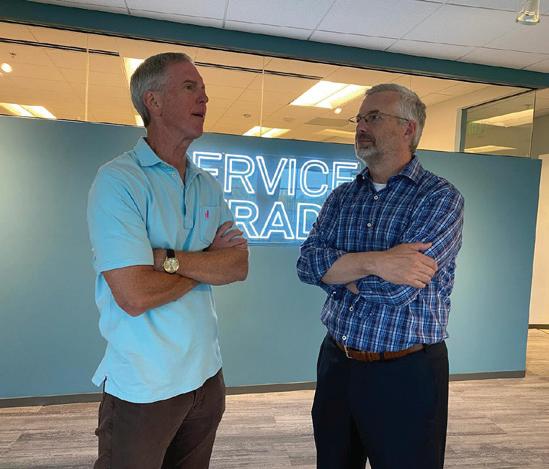








Given today’s market challenges, working with a local dedicated team driven by a shared vision can make all the di erence. Regions Commercial Relationship Managers know that developing a strong understanding of your business and its unique operations helps us provide highly responsive, personalized solutions. Let us leverage our capabilities and create a comprehensive financial strategy to help guide and strengthen your business.
Commercial Banking | Treasury Management Capital Markets | Specialized Industries
Thad Walton, SVP | North Carolina Commercial Banking Leader
704.770.3636 | thad.walton@regions.com
regions.com/commercial-banking




Since 19 technical sales people formed Tencarva in 1978, it has grown into a leading distributor of industrial pump equipment in about 11 states. e Greensboro company now employs more than 400. New York-based Bessemer Investors bought a major stake in the business in 2021. Ed Pearce joined TenCarva more than 30 years ago and became president in 2014.
Founder Keith Driscoll started the business more than a decade ago. For many years, Doosan Bobcat has named Atlantic to its list of top material handling dealers, based on sales, value and other dealer engagement metrics. It has sites in Charlotte and Columbia and Greenville, South Carolina.
e High Point-based company stands for Ready Upon Delivery. It was formed in 2018 to o er operators of commercial eet vehicles with a variety of services, including deliveries, leasing and titling, and nal touches such as washing. Drew Haire is president a er previously working for A.M. Haire, a omasville-based manufacturer of truck and van bodies.
Huber is the North American unit of a family owned German company that has annual revenue topping $200 million. It makes stainless steel products for municipal and industrial water and wastewater treatment plants. e company is based in Denver in Lincoln County, where it opened a new plant earlier this year. Henk-Jan van Ettekoven has been CEO since 2014.

























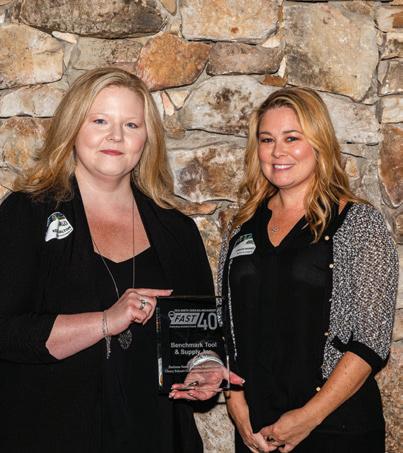










Thoughts on the economy from leaders of fast-growing NC companies.
What’s the business climate in North Carolina in late 2024? Business North Carolina asked leaders of fast-growing companies to share their views.
What are the main challenges your company is facing?
Dan McDonough, CEO, Commercial Credit Group, Charlotte “Our main challenges mirror that of our customers – the increased cost of running a business and attracting and retaining outstanding employees.”
Jen Yarros, chief financial officer, Quility, Swannanoa
We have no shortage of incredible ideas and an eagerness to execute on all of them, but we have learned the necessity of prioritization to ensure we focus on the projects, products, and platform enhancements that will be the most impactful and meaningful to our agents and our customers.
Stephen Dunn, president, Exeter Building, Raleigh
“Interest rates and presidential election years always provide challenges in the home building industry as buyers wait to see the outcomes of each. We feel the economy and market are still strong, but those factor into buyers’ decision-making.”
Ed Pearce, president, Tencarva Machinery, Greensboro “Finding talent continues to present challenges and some of our




manufacturing partners are still struggling to deliver products at preCOVID lead times.”
What are the key reasons for your company’s success this year?
Zeb Hadley, CEO, National Coatings, Raleigh
“Community engagement. National Coatings’’ ctive support for causes, such as Hurricane Helene relief in western North Carolina, has strengthened our reputation and relationships, showing clients and partners that the company truly cares.”
What does N.C.’s economy look like heading into 2025?
Tom Siler, executive vice president – finance, Epes Logistic Services, Greensboro
“A new administration (both in Washington and Raleigh), the lingering e ects of Hurricane Helene and ongoing concerns about the economy create uncertainty heading into 2025. We anticipate it will be somewhat of a transition year, marked by a gradual, albeit unremarkable, improvement in the economic outlook moving forward.”











Luke Blythe, president, Blythe Development, Charlotte
“I think the area’s economy will remain stronger than the greater economy. Really depends on the election and interest rates on how much growth we will see.”
Greg Dolan, CEO, Keen Decision Systems, Durham
“From a technology industry standpoint, there are few places to be better than North Carolina. Big tech is bringing lots of jobs and attention to our area. While this will continue to fuel economic growth for North Carolina, it will also create some challenges for smaller so ware companies, like Keen. Competition for talent, particularly developer talent, will de nitely heighten, and it will be more di cult to hire and retain this talent.”
Geoff Foster, CEO, Core Technology Molding, Greensboro
“ e outlook is very strong in North Carolina into 2025. Life sciences are getting tremendous traction, and our customers are building additional facilities in the state. With the new Toyota facility ramping up production in 2025, this will bring additional jobs to the state, as well as Boom Supersonic.”
John Lambert, chief operating officer, Prespro Homes & Neighborhoods, Harrisburg
“Overall, I believe the state’s economy is set to be one of the top ve economies in the country due to continued migration from other states and strong job prospects and overall quality of life for raising a family. Within this macro view is the ongoing massive need for new housing development. We are undersupplied as a country and as a state, so this bodes well for our line of business.”
Are you expecting your company to show significant growth in 2025?
Denis Kelly, CEO, Sunstates Security, Raleigh
“We anticipate hiring more than 5,000 employees in the next 12 months. Our continued growth, fueled by new client business and the expansion of existing accounts, necessitates a signi cant increase in our workforce across the country.”
Keith Driscoll, president, Atlantic Forklift Services, Charlotte
“We are expecting to grow in 2025, but not at the rate that we have achieved over the past ve years. Still double-digit, but not 20-plus percent.”



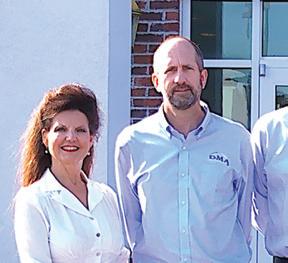













DMA has been igniting the industry landscape since 2008.
As the trusted supplier to the North American Automotive Parts Aftermarket, big box retail, wholesale, and e-tail sales channels. Our growth has been fueled by our unwavering commitment to delivering high-quality, cost-effective product lines that cater to key market needs.
Headquartered in Tabor City, North Carolina, with East and West Coast distribution facilities covering over 1.8 million sq. ft., our presence reaches
across the United States, showcasing our commitment to operational excellence.
With a dynamic, performancedriven work culture that embodies the entrepreneurial spirit, DMA is known for its commitment to hard work, collaboration, and an unwavering standard of ethics - values that have propelled us to success.
We proudly partner with a diverse network of international factories spanning seven countries, ensuring cutting-edge innovation and superior quality in all our aftermarket auto parts.

Our expanding product lines includes:
SENSEN® Shocks & Struts
SPEEDY STRUT® Complete Strut Assemblies
RIDEMASTER™
BRAKEMASTER™ Brake Rotors & Brake Wear Sensors
BULLDOG HD®
ATLAS™ Lift Supports
ATLAS Electro™ Lift Electric Lift Supports Heavy Duty Shocks, Cab Shocks & Steering Dampeners Coil Springs, Air Shocks, Control Arms & Light Chassis





August 28, 2024
The companies that were ranked among the fastest growing mid-market companies in N.C. enjoyed a golf/spa outing and awards reception at Grandover Resort & Spa in Greensboro.
Photos by John Gessner

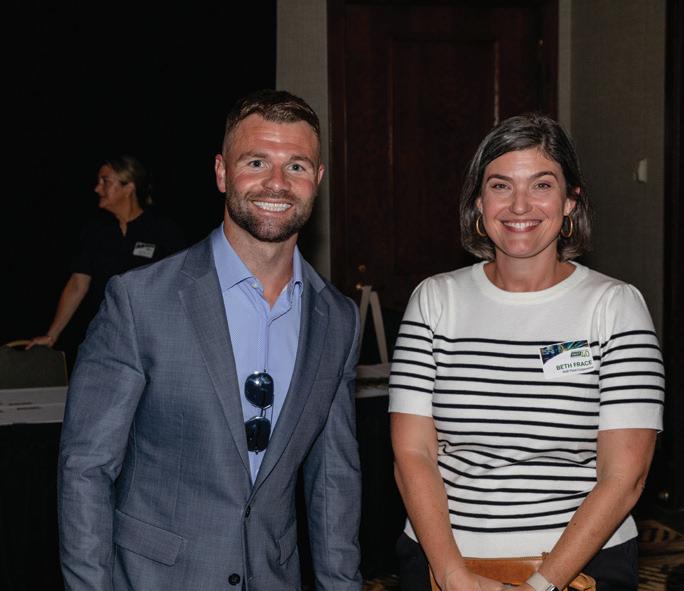




















By Kevin Ellis and Natalie Bradin
This marks the 11th year that Business North Carolina has saluted the most important new buildings that have opened across the state in the past year. The list contains massive investment from developers, businesses, healthcare organizations and others, and stretches from North Carolina’s coast to its mountains.
This year’s report cites 10 category winners and four honorable mentions. The BNC editorial team selected the buildings in mid-August with input from representatives of the state’s construction and architecture industries.
Much has changed for two Asheville hotels cited in the list – The Radical, a Hospitality category winner that opened in October 2023, and the Flat Iron Hotel, an honorable mention selection that opened in May. Both remained closed in mid-October due to the effects of flooding caused by Hurricane Helene, which devastated western North Carolina on Sept. 27.
While officials say neither hotel is believed to have suffered structural damage, both properties remained without running water weeks after the storm, just like much of Asheville. City officials aren’t sure how long it will take to restore service. Until then, both properties and much of Asheville are left waiting for the chance to again host guests to their globally famous community.


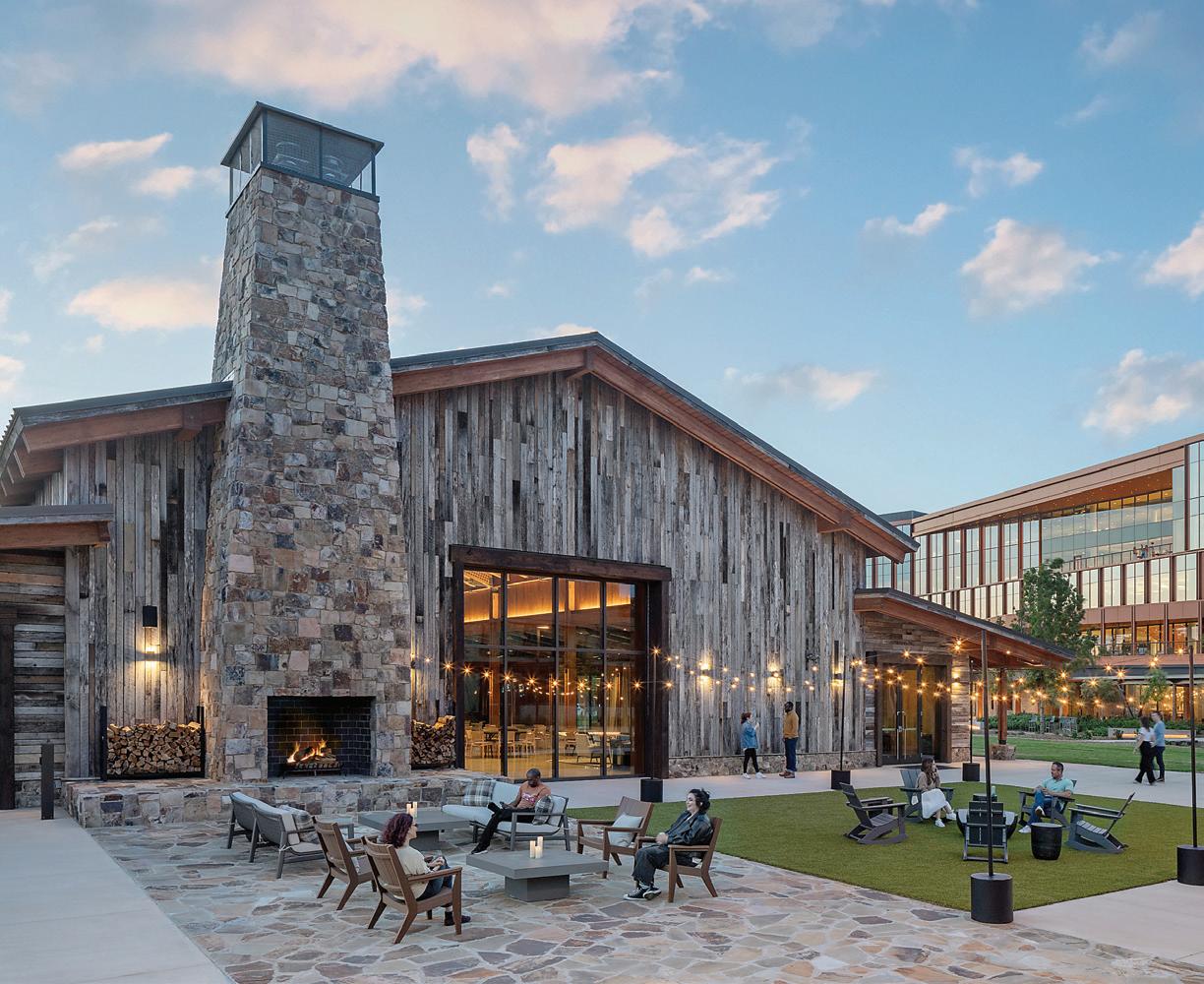


Developer: Bandwidth
Contractor: Brasfield & Gorrie (Birmingham, Alabama)
Architect: Gensler (San Francisco)
Cost: $103 million
Size: 550,000 square feet
Afive-story building on a 22-acre campus brought Bandwidth’s 750 workers, or Bandmates, under one roof. The building, which opened in August 2023, includes a Montessori-based child care center. Positioned amidst natural landscapes, the campus offers hiking and cycling opportunities. A fitness center, yoga studio and sports facilities promote employee well-being. David Morken cofounded Bandwidth in Raleigh almost 25 years ago.
The communications software company enables services such as 911, text messages and voice calls, with customers including Google, Microsoft and Zoom.
Bandwidth unveiled its plans in 2020, along with a pledge to create 1,165 jobs, for which the state offered Bandwidth about $32 million in incentives. In January, Bandwidth terminated the incentives package before receiving any money, saying it would not reach its hiring goals.
Shortly after the incentives announcement, Bandwidth acquired Belgian cloud communications provider Voxbone for about $520 million, expanding its reach into European and Asian markets. Growth at the combined companies has slowed and Bandwidth has reported a cumulative net loss of more than $65 million over the past four years.




Developer: Live Oak Bank
Contractor: Swinerton (Concord, California) and Monteith
Construction (Wilmington)
Architect: LS3P Associates (Charleston, South Carolina)
Cost: $25 million
Size: 66,438 square feet
The digital bank without branches has created a footprint with its largest addition to its $150 million, 100-acre campus in Wilmington. The four-story Building 4 opened in June, and like the others before was designed to blend with the forested site.
Construction of Building 4 is a first for eastern North Carolina, using a 100% mass timber structural system – a compressed, sustainable wood – under an exterior of cypress siding, metal panels and curtain walls that complement the campus’ serene aesthetic. Timberlab, Swinerton’s mass timber affiliate, performed the delegated design of the timber structure and prefabrication of the glulam timber and cross-laminated timber at its Greenville, South Carolina, facility. Mass timber construction is gaining popularity in the U.S., and is used more frequently in Europe and Canada.
Element designs such as exposed timber and natural light in the building connect workers to the natural beauty of the surrounding wooded area and campus pond.
Live Oak began in 2008 as a state-chartered bank with a national, online lending platform. It had total assets of $11.8 billion as of June 30. Live Oak opened the first building at its headquarters campus in 2013 with about 140 employees. It now has about 700 employees in Wilmington, and 1,000 overall. Building 4 can accommodate about 310 employees.




LDevelopers: Trammell Crow (Dallas) and co-development partners AECOM-Canyon Partners (Los Angeles) and HM Partners (Raleigh)
Contractor: Barnhill Contracting (Rocky Mount)
Architect: Gensler (San Francisco)
Cost: $186 million
Size: 365,000 square feet with 242 apartments, 166,000 square feet of office space and ground-floor retail
ocated three blocks west of the state Capitol on Harrington Street, the 20-story, 400H tower offers unobstructed views of downtown Raleigh. Apartments occupy floors 10 through 20 and feature full-height glass windows. Rents range from about $1,800 for a 618-square-foot space to almost $3,800 for 1,391 square feet. The ninth-floor sky-hub features an indoor-outdoor amenity center with a pool, fitness center, lounge and meeting space. A 20th floor penthouse offers a lounge accessible to residents.
Five floors of office space and ground-floor retail space are below the apartments and parking floors. Press Coffee, Cocktails & Crepe, which also has restaurants in Graham and Durham, opened in June. The Brass Tap Craft Beer Bar also has plans to open at 400H.
The building features a 24-foot, wood-framed green wall in the residential lobby and a 90-foot mural of a North Carolina saltwater marsh that greets office workers. Photos and murals in the building’s amenity spaces showcase North Carolina waterways, mountains and beaches. Between 1974 and 2013, Trammel Crow was involved in 67 projects in North Carolina, including some Charlotte office towers. The developer re-entered the state in 2021 with 400H as its signature project so far. As of mid-October, about 89% of the apartments had been leased and 10% of the office and retail space, according to Trammell Crow.






CHAPEL HILL
Developer: UNC Health
Contractor: Skanska (Stockholm, Sweden, New York City)
Architect: Page (Washington, D.C.)
Cost: $425 million
Size: 377,000 square feet

The North Carolina Surgical Hospital is the largest addition to the UNC Hospital campus since North Carolina Memorial Hospital opened its doors in 1952. The building opened in April, although the first surgery occurred Aug. 26. The expansion adds 80 beds, 26 operating rooms and a 15-bed observation unit to the hospital. Eventually, 500 people will work at the seven-story, surgery hospital, including 100 new positions. UNC Health expects between 17,000 and 18,000 surgeries per year in the tower.
The new hospital will treat patients in need of advanced surgical care. Larger operating rooms offer ample space for specialized procedures, such as organ transplants. Four operating rooms are designated “hybrid spaces,” which integrate imaging technology into surgical procedures to enhance efficiency.
Construction took five years to complete. Design features are meant to offer patients and families a sense of peace and respite during some of their most unsettling days. The hospital connects to the existing five-building UNC Medical Center campus. It is part of UNC Health, which is owned by the state of North Carolina. Both Skanska and Page have offices in North Carolina.

Developer: Forsyth County
Contractors: Balfour Beatty/Samet (Joint Venture) (Balfour Beatty HQ, London) (Samet HQ, Greensboro)
Architect: CJMW Architecture (Winston-Salem)
Cost: $96 million
Size: 240,000 square feet


Forsyth County’s fifth courthouse is more than triple the size of the former, 48-year-old courthouse it has replaced. The new version has six floors and 17 courtrooms, and was designed to allow for more courtrooms in the future. The former Hall of Justice, which opened in 1975, had 14 courtrooms. The new courthouse can accommodate a staff of more than 2,000.
Features include:
• A single location on the first floor for most Clerk of Court services
• Rooms for defendants to consult with their attorneys
• Space for the Public Defender’s offices, which had been housed in a separate building
• A secure tunnel for transferring inmates between the
courthouse and detention center
• Separate transportation corridors for in-custody defendants, the general public and courthouse personnel.
• A secure bridge to the Government Center, giving staff access to the courthouse.
Construction on the courthouse started in 2021 and the court sessions were first held in the building on Oct. 23, 2023. Forsyth County put up for sale more than 600 items from the former courthouse, including pay phones, vacuum cleaners, metal detectors and water fountains. The old courthouse is up for sale. The county’s third courthouse, built in 1926, was converted to downtown condos.




WINSTON-SALEM
Developer: Forsyth County
Contractor: Blum Construction (Winston-Salem)
Architects: Gensler (San Francisco) Stitch Design Shop (Winston-Salem)
Cost: $47.5 million
Size: 70,000 square feet
The word Kaleideum was formed by the merger of the words “kaleidoscope” and “museum.” The construction of the building was also inspired by the geometric forms and triangulated shapes captured in a kaleidoscope, as designers were looking to create a fusion of art and innovative design in the new museum.
Exhibits fill four stories of the building. A two-level “Rooftop Adventure” area features a playground, woven climber and revenuegenerating covered event space that offers one-of-a-kind views of the Winston-Salem skyline. The basement has offices and storage space.
Kaleideum leaders expect the museum to attract 300,000 visitors in its first year, creating a $10 million economic impact. That compares to $6.8 million previously.
Forsyth County leases the building for a dollar a year to Kaleideum, which was created by the merger of The Children’s Museum of Winston Salem and Sci-Works. Funding for the museum began in 2017, with construction starting in July 2021. The museum opened in February at the site of the former Forsyth County Sheriff’s Office, which was torn down four years ago.
Forsyth County invested $30.5 million, while a successful $15 million capital campaign contributed to the project. The museum received gifts of $2.25 million from the L. David Mounts Foundation, $2 million from Novant Health and $1 million from Atrium Health Wake Forest Baptist.

OAKBORO
Developer: Charlotte Pipe and Foundry
Contractor: Barringer Construction (Charlotte)
Architect: WGM Design (Charlotte)
Cost: $460 million
Size: 530,182-square-feet foundry (605,042 square feet total)
After forging cast iron into pipes for more than a century near the Queen City’s center city, Charlotte Pipe moved 35 miles east to 700 acres in Oakboro in Stanly County. The foundry became fully operational in September 2023, after as many as 500 construction workers a day logged more than 1.2 million hours of work. Construction supplies and materials were 100% made in the U.S., officials said.
The 123-year-old company has been owned by the Dowd family since its inception.
At the plant, Charlotte Pipe invested $58 million in its environmental systems and controls. The biggest change was transitioning to electricity to forge the iron. The former foundry used a coal product. The change reduces annual carbon emissions by 40,000 tons, which the EPA says is equivalent to a year’s worth of carbon emissions from 32,638 gasoline-powered passenger vehicles. A 70,000-megawatt substation for the plant, fueled by natural gas distributed by Union Power Cooperative, produces enough electricity to power 70,000 single-family homes.
Charlotte Pipe has about 2,500 employees at 10 plants in eight states, including 563 who work in Oakboro.
In September, Charlotte Pipe chose Dallas-based Trammell Crow to develop its 5.5-acre Iron District, the location of its former foundry. Located near Bank of America Stadium, Trammell Crow’s initial plan calls for a hotel, housing and office space.
Charlotte Pipe is also building a new headquarters and training center in the city’s Eastover neighborhood.








Developer: Hatteras Sky (Atlanta)
Contractor: Beverly-Grant (Asheville)
Architect: Rowhouse Architects (Asheville)
Cost: $44.6 million
Size: 63,030 square feet
Built in the 1920s, the five-story building had been everything from a breakfast cereal factory to a distribution hub for wholesale grocers to abandoned before opening in October 2023 as the Radical Hotel, a 70-room boutique hospitality space in Asheville’s River Arts District. The “Rad” was designed to fit the vibe of the River Arts District, home to numerous art studios, bars, restaurants, music venues and breweries. That district was hit hard by the Sept. 27 storm surge caused by Hurricane Helene.
As of mid-October, The Radical remained closed with no timetable for re-opening. The Radical had some flooding, but no structural damage, and no damage to its second-floor lobby or guest rooms. The Radical hosted emergency responders immediately after the storm hit.
The Radical has been described as a “love letter to the city’s creative spirit.”
The updated building boasts towering concrete pillars, exposed brick walls and original street art. Those graffitied walls are now complemented with a curated collection of 200 works of contemporary art. Guest rooms are adorned with murals and custom-made furniture. Interior work was done by New York-based Suomi Design Works and Portland, Mainebased Might & Main, and “inspired by 1970s fashionistas and 1980s Berlin, with a dash of punk, a sprinkle of disco and a penchant for antiquing.” The property’s tax value increased from $2.7 million in 2021 to almost $11.7 million in 2024, according to Buncombe County tax records.
James Beard award finalist Jacob Sessoms oversees the food and beverage concepts in the new hotel.




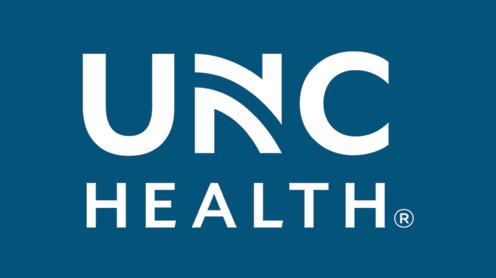



What makes a building? Steel? Glass? At the North Carolina Surgical Hospital, it’s people and their steely resolve to overcome the impossible–along with a warmth that reflects our mission to provide compassionate care to everyone we serve. We’re proud to say that we offer the latest groundbreaking technology, procedures and understanding. And we’re now open. unchealth.org/surgicalhospital
Developer: Wells Fargo (San Francisco)
Contractor: Rodgers Construction (Charlotte) and Barringer Construction (Charlotte)
Architects: Gensler (San Francisco) and Perkins & Will (Chicago)
Cost: Part of five-year $500 million investment
Size: 2.1 million square foot campus
The Customer Information Center campus is the home office to more than 10,000 employees of the third-largest U.S. bank. Work kicked off last year to modernize the workplace, which predecessor bank First Union opened in 1995. It includes more workspaces, new contact center space, a revamped food hall, and a new 2,500-space parking deck. Three full-floor renovations and the first phase of the food hall enhancements are done, with five additional fullfloor renovations, and the new parking deck set to deliver in December.




Developer: Classic Group (Morrisville)
Contractor: Classic Construction (Morrisville)
Architects: Ora Architecture (Raleigh)
Cost: About $10 million Size: 31,500 square feet
Opened in June 2023 by Kishor Karneria, the three-story RDU Galleria is a combination gas station, convenience store and office building. It attracts travelers using RaleighDurham International Airport, which is about two miles north. Office space is for lease on the top two floors.































CHARLOTTE
Developer: Crescent Communities (Charlotte)
Contractor: Choate Construction (Charlotte)
Architect: BB+M Architecture (Charlotte)
Cost: $21 million
Size: 125,000 square feet
On the corner of East 7th Street and North Caswell Road, Elizabeth on 7th is a modern commercial office space situated in a historic area of Charlotte. This four-story space offers 103,500 square feet of Class A office space along with 22,000 square feet of retail. Elizabeth on 7th is currently home to businesses like Catalina Kitchen & Bar, The Yard Milkshake Bar and Barre3.

Developer: Jacob Smith
Contractor: Eagles Properties (Goldsboro)
Architects: N/A
Cost: Sold for $950,000 in April 2023
Size: 20,500 square feet
Built in 1980, the four-story One Spence Center of Goldsboro is a former bank building that was converted into office space. This type of development is unusual for a small town like Goldsboro. Currently, there are nine spaces available for lease at the Spence Center.

ASHEVILLE
Developer: Flat Iron Preservation Group
Contractor: Whiting-Turner Contracting (Baltimore), Beverly-Grant
Construction (Asheville)
Architects: Rowhouse Architects (Asheville)
Cost: $36 million
Size: 52,000 square feet
Constructed in 1926, Asheville’s historic Flat Iron building reopened as a boutique hotel in May. The nine-story hotel offers 71 guest rooms and six suites, with rates starting at $200 per night. The Flat Iron Hotel offers guests high-end Italian dining at Luminosa and panoramic views of Asheville and the Blue Ridge Mountains at its rooftop bar.
The Flat Iron has been closed since the Sept. 27 storm surge from Hurricane Helene. Like a lot of downtown Asheville, the building did not have running water as of midOctober and does not have a timetable of when that would change. The building did not receive structural damage from the storm.



































For over two decades, Metcon has been delivering top-tier construction services to both public and private clients across North Carolina, setting the standard for quality and innovation.




Developers: Stiles (Fort Lauderdale, Florida) and Shorenstein
Properties (San Francisco)
Contractor: Shelco (Charlotte)
Architect: Hastings Architecture (Nashville, Tennessee)
Cost: $186 million
Size: 370,000 square feet
This 23-story Class A office space opened in May and in June won a prestigious Digie Award for “Most Intelligent Office Building” at the annual Realcomm | IBcon Conference held in Tampa, Florida. The award focuses on sustainability and connectivity factors.
Amenities include an 11th-floor sky lobby with sweeping views of Charlotte’s Uptown skyline, a 4,000-square-foot fitness center and flexible conference space. Office space on 12 floors features 29,000 square-foot floor plates, 13-feet-4-inch floor-to-floor ceiling heights with 11-foot clear vision glass to maximize light, volume and transparency.
The building is on a platform for a direct stop by the Lynx Light Rail and adjacent to the Charlotte Rail Trail.
As of mid-October, the building was vacant.


By Alyssa Pressler
Having grown up in upstate New York, I’ve noticed something very di erent about North Carolina during my almost nine years living here: ere’s a big emphasis on traveling throughout the state and exploring the many quaint towns and cities that exist here. In New York I don’t recall ever hearing folks talk about their weekend trips to neighboring towns, but that’s the norm around here, and it’s easy to see why.
From Winston-Salem to Saxapahaw, there are towns throughout the state working mindfully to create a warm, welcoming and exciting environment for locals and visitors alike. ere are so many gems you can visit without ever leaving the state, and that’s something that feels particularly special to North Carolina. In the following pages you’ll learn a bit more about what Winston-Salem and Saxapahaw have to o er those who visit. Turn the page to learn more.






In the heart of Winston-Salem, we’re new grounds. A 100 acre development adjacent to Wake Forest University,

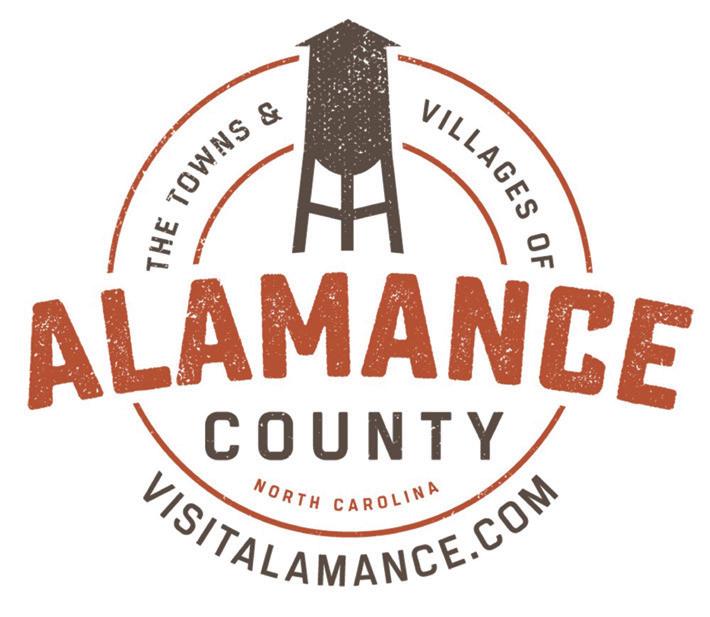
Saxapahaw might not be a name you’ve heard tossed around much on those “must visit” lists you see touting towns and cities across North Carolina, but the 198,000 visitors who dropped in on the unincorporated river village in 2023 might challenge that.
Especially when you consider that 60,000 of those folks traveled more than 25 miles to spend time in the quaint mill town, according to data provided by Placer AI. Since Saxapahaw’s historic mills were revitalized a decade ago, the village has become an increasingly popular destination for those looking for a peaceful, outdoor-focused place to visit.
In fact, since Business North Carolina reported on the town in 2015, annual visitors have more than quintupled, all looking to enjoy the Haw River, the history around the town and the close proximity to Chapel Hill (only a 25-minute drive). With the opening of the Saxapahaw Campground and the expansion of Haw River Canoe & Kayak Company, the town has become a haven for those looking to slow down and get in touch with nature.
“We also have many cyclists that come through and make a stop because it’s a very relaxing, beautiful location to do so,” says Grace VandeVisser, executive director of the Alamance County Visitors Bureau and a former Saxapahaw resident.
e town is named a er the Sissipahaw Indians who once called the area home. More recently, Saxapahaw housed mills which produced cotton for the Confederate Army. A er a destructive tornado in 1994, the mills sat empty until local real-estate developer Mac Jordan


combined forces with Heather LaGarde and her husband Tom, a former UNC basketball star and NBA player, with the goal of revitalizing the mills while preserving their history.
Now the mills are home to apartments as well as businesses and nonpro ts.
Walking through the village, visitors will nd the Saxapahaw Historical Museum, the Hawbridge School, the Saxapahaw General Store and Culture Mill, among others.
roughout the year the Haw River Ballroom hosts countless events for residents and visitors alike. Folks can grab a beer made with local ingredients at Haw River Farmhouse Ales, the county’s rst brewery, or grab dinner at e Eddy Pub, overlooking the Haw River. If you head out away from the mills, you’ll nd local farms you can visit — many of whom provide produce and other goods to the Saxapahaw store, restaurants and brewery.
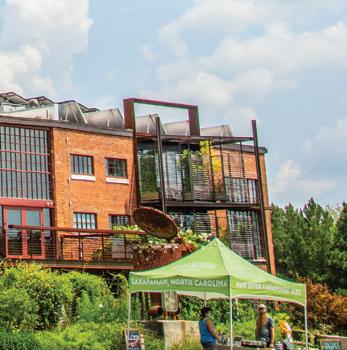

e energy ramps up even more with the holidays in Saxapahaw, largely thanks to the popular Saxapahaw Holiday Market in December, which features live music, local vendors and more.
VandeVisser rst moved to Saxapahaw from Maryland in 2013, and quickly fell in love with the charming area.
“My favorite part had to have been the proximity to the river. I’m a coastal person so it kept me attached to that natural environment,” she says. “It’s a very lively, yet peaceful little town.”







In the heart of Winston-Salem, we’re breaking new grounds. A 100 acre development adjacent to Wake Forest University, soon to become your favorite stomping ground. The gathering ground, where locals and visitors find common ground. From shopping grounds, to dining grounds, to concert grounds, to your game-day battleground. We’re laying the groundwork for something unforgettable. This is The Grounds , where the future of Winston-Salem takes root.








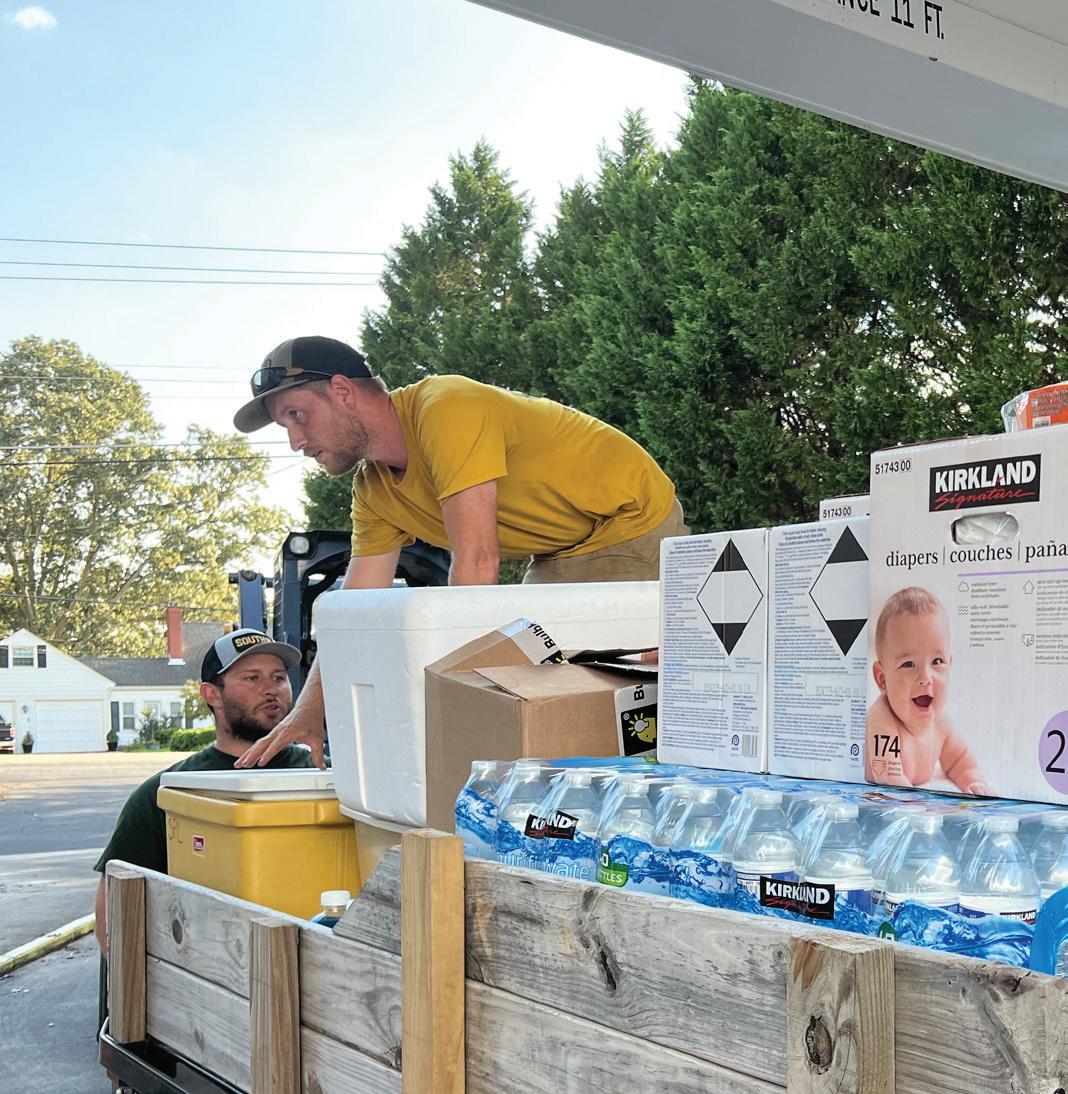

Soon a er Helene’s damaging remnants had passed over Brian Walker’s Asheville neighborhood in late September, the buzz from chainsaws cranked up. Folks cleared their own fallen trees and then moved on to their neighbors. ose without chainsaws provided food and drinks for those clearing trees and roads. Everyone pitched in, says Walker, a vice president at Je erson-based Vannoy Construction. at spirit of neighbor-helping-neighbor showed no signs of letting up weeks a er Helene rst came to shore some 450 miles away in north-central Florida, says Walker.
Vannoy and other construction companies play a pivotal role in the recovery, he says.
“We’re trying to nd our place and how our skill sets can best be put to use to help bring our community back together,” says Walker. “If we can repair a building or help get a company back in operation, those are the people that can then provide jobs so that people can get people back to work and begin to put food on their tables again.”
While some areas and people will need time to decide whether to rebuild, Walker predicts western North Carolina’s resilience will shine through.
“It’s hard to imagine an Asheville that doesn’t have a Biltmore Village, and it’s hard to imagine a Rutherford County without a Chimney Rock,” he says.

Asheville’s Aeroflow escaped serious damage, enabling a focus on helping suffering staffers.
By Kevin Ellis
Hurricane Helene caused minimal disruption to Asheville medical equipment company Aeroflow Health, although dozens of employees were not as lucky, says CEO Casey Hite. While the company that ships breastfeeding pumps, diapers, diabetic supplies and other products nationwide recovered quickly, officials geared their efforts toward helping hundreds of employees left struggling because of the storm.
“In some cases, we had employees riding to other employee’s homes on ATVs to make sure they were OK,” says Hite. Aeroflow created a $400,000 relief fund for workers’ needs, and made simpler moves like creating a pantry at its office, so employees could stock up on supplies.
When Buncombe County businesses became cash-only due to widespread power outages, Aeroflow employees in unaffected areas were asked to withdraw money from their accounts, and then have the company reimburse them. Employees then drove that cash to company headquarters to be divvied out for workers who needed hard currency.
Hite says he would like to say Aeroflow had an emergency plan in place to deal with a gargantuan natural disaster. But like so many others, it was left scrambling by the recordsetting flooding, he says. Instead, Aeroflow was guided by principles of remaining flexible and focusing on what it could do to help employees.
“In any business you want all of your staff to operate as owners and the one way to do that is to treat them as owners and access resources when they’re in a time of need,” says Hite. “One of the highest costs for any company is employee turnover, but doing what’s right for your people, people will remember that, people appreciate it, and it builds loyalty.”
Aeroflow has about 1,000 total employees, including 600 in Buncombe County. Most local employees are involved in customer service and about three-fourths of them normally work from home. No employees lost their lives or suffered a serious injury, although several had family members or close friends who did, says Hite.
About 55 employees lost their homes or had severe damage. Company lobbyist Heath Shuler, a former NFL quarterback and congressman, used his connections with Harrah’s Cherokee Hotel and Casino to help secure rooms there for employees. The Eastern Band of Cherokee Indians came through for Aeroflow employees when they needed help, Hite says.
Aeroflow used generators to provide electricity to its buildings when necessary, but it lacked internet service from three separate providers for about 36 hours. Many employees who had worked from home remained without the internet as of mid-October. Within a week, about 85% of Aeroflow’s employees had returned to work, with more working from the office than usual, Hite says.
Aeroflow opened a temporary childcare facility at its office since many such businesses were closed. That allowed employees to bring older children to the office while schools were closed. “It’s a little noisy, but we feel that’s the right thing to do and we think our customers will understand if they hear a child in the background from time to time,” says Hite. When calm returns, Aeroflow will look at what it did right, and what it can improve on during future emergencies. He predicts it will take years for some communities to recover.
Aeroflow is among Asheville’s most successful companies, having Inc. magazine’s ranking of fastest-growing top 5,000 companies for eight of the past nine years. Revenue increased 143% over the past three years, Inc., according to Inc. The disaster did come with a rainbow.
“The differences between folks in our community have literally been thrown to the side. It’s like they don’t exist,” says Hite. “We have a liberal hippie in downtown Asheville working hand in hand with a logger who may live 60 miles away who has come in to help assist.” ■

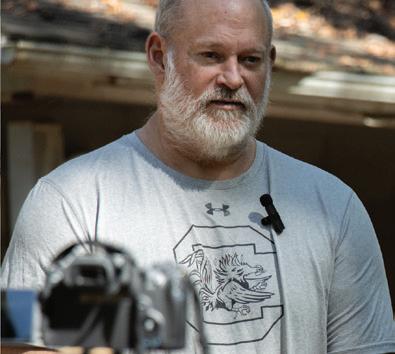





A McDowell County family rebounds after losing their campground business.
By Noelle Harff


At 9 a.m. on Sept. 27, Pat and Charlie Gowan wedged beach towels underneath their front door, attempting to stop water from entering their house. An hour later, the home and Triple C Campground, opened 49 years ago by Charlie’s parents, were washed away.
The Catawba River near the Gowans’ home rose to a record-breaking 21.44-foot average depth near Pleasant Gardens in McDowell County, between Old Fort and Marion. The Gowans couldn’t keep the water out. Exiting the front door wasn’t an option because water was up to the door knob. “It’s not rising water, it’s rushing water,” Charlie
explains. “There’s a change of elevation… water gets momentum and tears everything up.”
Around 10 a.m., Pat, Charlie, and their daughter, Elizabeth, 16, escaped out the back window, crossed the road, and climbed a hill 20 yards away.
Minutes later, they watched their family home become unmoored, and their campground wash away.
The Gowans’ two elder children were at their colleges, Gwen at UNC Chapel Hill and Joseph at Appalachian State. They frantically texted their parents. It wasn’t until days later that they received a response: “We’re OK,” was all the message said. “We didn’t want to worry them,” Pat explains.
While the Appalachian Mountains is one of the world’s oldest ranges, having weathered many storms, no one expected anything like this.
The Gowans’ campground was a beloved mountainous spot, where families would return year after year. The camp, open from May to October, has about 80 plots owned by individuals and cared for by the family. “A plot is for sale for maybe a day, and just like that, it’s sold,” Pat says.






Tourism industry appreciates support in trying times.
By Kevin Ellis
The first snow of the season fell in Watauga County on Oct. 16, the same day that Appalachian State students returned to class following an extended break related to the destructive flooding from Helene.
That was also near the height of the leaf-watching season in the High Country, a time when restaurants, shops and hotels are usually filled with visitors anticipating nature’s glory. Boone and Blowing Rock had already welcomed back visitors at that time, although outlying areas were still dealing with utility and road crews making repairs. The Blue Ridge Parkway, one of the most scenic roads in the nation on a crisp fall day with the leaves yellow and red, remained too dangerous for traffic, with the National Park Service offering no timeline for the North Carolina portion to reopen.
“Tread lightly” are the cautionary words to visitors from David Jackson, president of the Boone Area Chamber of Commerce.
The Gowans don’t advertise or have a website. “We don’t need to,” Pat says. “Or didn’t. I never know which tense to use.”
The only full-time resident at Triple C is Hillbilly. “One time a package came for John Owens,” Pat says, but he doesn’t usually respond to that. “I’m Triple C’s security and maintenance,” Owens says. In exchange for living on the Gowans’ land with his dog Spice, Hillbilly helps out around camp. Every time something gets fixed, a zero gets added to his salary, Pat jokes.
Walking through what used to be Triple C Campground, the devastation is clear. Chinook helicopters flew overhead 10 days after the storm. The rescue missions had ended, but military personnel were still searching.
In the first days after the storm, more than 100 people in the area around the campground were missing, says Neal Donnelly, a local emergency paramedic. By Oct. 9, it was five.
The campground is covered in feet of mud and fallen trees. Each campsite, once decorated with lights, signs and porches, was a mass of wreckage. The Gowans’ four-bedroom, one-story home was lifted off its foundation and moved 20 feet.
“I have to start looking and find a landmark to know where I’m at… It looks totally different now,” Charlie says. As of mid-October, Charlie’s brothers had yet to see what used to be their childhood home and family business. “My older brother, he’s going through chemo, so he’s pretty sick right now,” he says. His younger brother manages a group home.
Now, the Gowans are left grappling with what to do next. “There are just piles of trees,” Charlie says, stepping over Gwen’s muddied high school graduation cap. She was valedictorian at McDowell High School.
Charlie and Hillbilly have cut through fallen oaks and cleared roads, but much of the cleanup can’t start until FEMA completes its damage report. The family is unsure of what aid is available.
Triple C will need a new sewer system, new water lines and reinstated power. “We’re talking millions of dollars,” Pat says. “It’s a big decision. We don’t know what to do next. Th is was our retirement plan.”
Emergency small business relief from the state exists as loans with interest rates ranging from 4% to 8%. Taking on
substantial loans in his mid-50s would be difficult, “I don’t want to pass that debt onto my children,” he says.
Small businesses across Appalachia face the same dilemma. According to the Federal Emergency Management Agency, 43% of small businesses affected by a disaster never reopen, and another 29% go out of business within two years.
The Gowans have hope. “People have truly taken care of us,” Pat says, her voice cracking. “And I’ve probably cried more about that than losing everything.”
Churches from across the county have provided food, water, and shelter. First responders and military personnel from across the country are sleeping in tents and cots, waking up at dawn to help those still trapped in their homes.
“I acknowledge that this is hard. Very hard… but we can do hard things,” Pat says.
After the storm, she sent her children a Bible verse, Romans 15:13: May the God of hope fill you with all joy and peace as you trust in him.
“We put our trust in God,” Pat says. ■

“Come to Boone and Blowing Rock, but maybe stick to the main cities, and spend money. That’s going to be a part of our healing and economic recovery.”
Tourism is cyclical in the mountains, says Jackson, with an important measuring stick on the horizon for the community.
“Ski season is a finish line we hope we can get to,” adds Jackson. “Maybe by the time winter rolls around we will all feel like a community that can welcome people in a way they are used to.” Jackson says people in the mountains are resilient and appreciative of the help they’ve received. Business people talk of the many area codes they see from people buying gift cards to support the area.
“It’s clear people have a passion for this place and not just Boone, but all of western North Carolina,” says Jackson. “The hospitality that the mountains of North Carolina have provided for decades has been paid back to us in one of our greatest times of need and we’re not going to forget that.”
Jackson was speaking about recovery on the same day news broke that the Small Business Administration had run out of money for the disaster assistance loans it offers businesses, homeowners and renters. That could delay relief unless Congress appropriates more money. Other programs exist, such as the Federal Emergency Management Agency, or FEMA, but the
SBA news was like a kick in the gut, says Jackson.
“We need to get politics out of disaster relief,” he says. Business people are already going to struggle if they have to take on new loans while they risk recovery efforts could stall.
Closer to home, Jackson says that community banks are working with customers, helping them in a multitude of ways. Utilities Blue Ridge Energy and New River Light and Power have also reached to support people struggling to pay their bills.
“The spirit of helping, generosity and kindness has been there,” says Jackson. ■


Churches are poised to help develop sorely needed affordable housing.
But the devil’s in the details.
By Rev. Dr. John Cleghorn
Fred Dodson knows dirt. On a small family farm in the Chestnut Knob community of south Virginia, he learned how to coax vegetables out of the ground that helped feed the family, alongside raising a few chickens and pigs. These days, he still loves to steal away from his job as chief operating officer of the DreamKey Partners nonprofit in Charlotte to work in his home garden. “It’s good therapy,” he says.
DreamKey coaxes a different kind of life-giving resource out of the ground, namely housing for middle- and lower-income seniors, veterans, families and the unhoused. As in farming, DreamKey’s success depends on the right kind of soil — the affordable kind. But it’s getting hard to find. To make its thin-margin deals work, his firm, one of the largest in the state, is adapting.
“Fifteen to 20 years ago, we could find 15 acres that were not contaminated or on a major thoroughfare for purchase for about $1.5 million,” he says. “Now, all we can find are irregularly shaped parcels, smaller and often with some type of contamination. To make the numbers work in our business, we know we have to be creative in what we build and we are. The problem is there just isn’t enough land that fits our economics.”
In response, affordable housing providers are turning more to an unusual source of land for development. Every week, Dodson speaks with church pastors and congregational leaders about what is possible at houses of faith. DreamKey has several such projects at or near the construction phase, plus five or six more in the pipeline. “So many churches are trying to figure out how they are going to survive, and I know market-rate developers are knocking on their doors as well,” he says.
Therein lies the story of a fast-moving national movement. In almost every community, houses of faith occupy well-placed, under-used properties in prime neighborhoods and near schools, transit, and employment centers. As odd bedfellows, church leaders are learning the basics of land development, and affordable housing developers are learning about church governance, polity and finance laced with scriptural and theological motivations.
It’s a journey I’ve been on for more than a decade. I serve Caldwell Presbyterian Church in the Elizabeth neighborhood near uptown Charlotte. In partnership with DreamKey, our church is converting a 14,000-square-foot building that once housed Sunday school classrooms into 21 studio apartments for people coming out of chronic homelessness. To operate the property and offer social services, we are partnering with Roof Above, Charlotte’s largest nonprofit agency working on homelessness. Our neighbors are scheduled to move in around Easter 2025. Meantime, we are learning all we can, as fast as we can, to be good neighbors as our new arrivals gain stability and, where needed, healing.
The $6 million construction cost is covered by the Caldwell congregation, Myers Park United Methodist Church, a private foundation and city, county, state and federal funding sources. That will enable the initiative, Easter’s Home, to open its doors debt-free. It will provide shelter, plus community and supportive housing to those often hardest to house, people earning 30% to 50% of the area median income, or from $22,300 to $37,100 per individual. Residents will receive free, required case management and connections to services they need to reach their goals. I never imagined I would be in the housing development business, but in the faith business this might be what we call “providence.” This project calls on my three professions spanning four decades in Charlotte, including business journalism, communications and policy roles at Bank of America’s Charlotte headquarters and the last 17 as a minister at Caldwell, hustling to keep up with its thriving, progressive ministries. That trajectory provided a front-row seat to how two national crises are intersecting.
Those crises are a deep housing shortage and the upending of the American religious landscape. The former reflects a gap in housing supply heightened by the industry’s sharp downturn amid the Great Recession of 2008-10. More recently, pandemicdriven increases in housing costs, lagging wages and the sheer complexity of building homes that are both affordable for buyers and profitable for builders.
North Carolina’s local governments are scrambling to address a reality in which 1.2 million households, about one in four, are paying more than 30% of their income on housing. In the state’s biggest cities, middle- and lowerincome workers in the hospitality, healthcare and trades sectors are moving out of central urban areas to lower-cost suburbs and exurbs. The state needs more than 100,000 new affordable units immediately, industry officials say.
Meanwhile, the peak of Christendom, at least as measured in participation in organized religion, is past. Gallup reports that only three in 10 adults attend worship regularly. Even fewer Americans belong to a church or claim a particular faith. God’s church has adapted for centuries. Now, many churches face questions about how to sustain their propertyheavy operating models.
As many as one in three congregations will consider closing their doors over the next 15 years, unable to meet expenses for operations, maintenance, pastor and staff salaries and community outreach. In the 1.7-million-member Presbyterian Church (USA), 100,000 church properties will change hands by 2030, a denominational scholar estimates.
The tumult may free up tens of thousands of acres in prime locations from coast to coast. In general, churches are repurposing their land or under-used buildings for three reasons. Some are caring for neighbors, a theme that echoes through the Judeo-Christian scriptures. A second group is burdened with maintenance costs for leaking roofs, broken HVAC systems, deteriorating parking lots and aging pipe organs that no longer lift a joyful noise. A third group of congregations have dwindled to a remnant of older, tired members. Should the doors close, they still want to leave a legacy of service.
This movement represents a wide range of examples, each with unique contexts and challenges. If you have seen one church housing redevelopment deal, you’ve seen one church land development deal. Each plays out of its own factors and challenges.
164,823









In Charlotte, newcomers often say there seems to be a church on every corner. Founded by sturdy Scots-Irish Presbyterians in the early to mid 18th century, and later the hometown of the Rev. Billy Graham, Charlotte considers itself a “city of churches.” Today the city is a microcosm of the faithin-housing movement.
Black congregations showed the way, spurred by the destruction and displacement of 1960s urban renewal. For decades the center of life for more than 1,000 Black families, the downtown Brooklyn neighborhood was bulldozed with unflinching support from elected officials and the city’s elite. Years later, central city Black churches vowed to control and steward their land to forestall a repeat of displacement.
In the 1980s, near the old Brooklyn neighborhood, Grace Emmanuel Baptist built Emmanuel Homes, a community of 50 affordable apartments in the shadow of Charlotte’s growing skyline.
In 2017, St. Paul Baptist Church, having also been displaced from the central city, built a village of 121 affordable rental and for-purchase units, for those earning no more than 60% of the area median income. The church hired Laurel Street Residential and gained capital from one of the first infusions from Charlotte’s voter-approved Housing Trust Fund.
Next to its sanctuary, Little Rock AME Zion Church partnered with the city to build 105 apartments in uptown Charlotte, half affordable and half rented at market rates. The property is co-owned by the church and Laurel Street.
In north Charlotte, Mayfield Memorial Baptist Church withstood years of neighborhood change, gang violence and adjacent privately owned housing renting out bedrooms for $1,000 a month or more. Prevailing against some neighborhood opposition, the church partnered with DreamKey to open Sugaree Place last year. Rents run from about $400 to $547 a month for residents earning 30% of the area median income.
Greater Bethel AME Church in north Charlotte sold a wooded, 9-acre tract to the local Habitat for Humanity chapter at a below-market price, opening the way for more than twodozen, for-sale affordable homes.
More recently, predominantly white churches with spacious grounds have stepped in. In northeast Mecklenburg County, Newell Presbyterian Church sits on 10 acres, near rows of tract housing that cover what had been rolling fields of corn and other crops. Newell plans a village of about 50 for-sale homes for those earning 60% to 80% of the area median.
Other congregations bring capital. Covenant Presbyterian

in the city’s Dilworth neighborhood, with no extra land of its own, has funded hundreds of affordable units with various partners while investing about $5.5 million. Its partners include the Greater Bethel AME land transfer.
In the Triangle metro area, a range of innovative faith partners are also asserting a “Yes in God’s backyard” attitude instead of “Not in my backyard.”
As it planned a new church campus, the small Chapel Hill congregation of The (Episcopal) Church of the Advocate partnered with Pee Wee Homes for three tiny homes on about 5,000 square feet of land. They provide transitional housing for the unhoused. The units share a parking lot and utilities with the congregation.
In east Raleigh, Milner Memorial Presbyterian Church was demolished and is making way for 156 affordable units for people aged 55 and older. The nonprofit housing developer DHIC worked with the church, the regional office of the Presbyterian Church (USA) and developer Brightspire to create a legacy on Milner’s 4.6-acre site. Leasing began this fall.
In suburban Cary, Greenwood Forest Baptist Church plans 80-plus affordable rental units on its property.
In Fuquay-Varina, Juniper Level Missionary Baptist Church is exploring its property potential, as is First Baptist-Raleigh.
Even with the high demand for more accessibly priced housing, and churches’ urgency to chart their futures, the movement faces a range of hurdles that stall prospective projects.
Developers say congregations often jump in without discerning which population they feel called to serve and whether there is enough revenue to make the project feasible. Partners say they sometimes learn, after months of effort, that they have been working with a church representative who lacks the authority to make decisions or that a congregation hasn’t really reached consensus.
There are various ecclesiastical governance structures: the Roman Catholics, United Methodists and Episcopalians tend to have clear lines of authority, while Presbyterian and Lutheran governing bodies often entrust land to individual churches but retain ownership and final control. Baptist and other independent churches often have clear autonomy.
“This movement of churches developing their land is like a no-brainer. They support the mission of the church and serve ‘the least of us,’” says Yolanda Winstead, CEO of DHIC, Raleigh’s largest nonprofit housing developer. But the concept’s novelty and congregations’ inexperience mean “we are building


▲ Park United Methodist Church, led by the Rev. David Hiatt, wants to partner with a private business on a senior-housing center. Town officials have questioned the project’s height, slowing its progress.
the plane while we are flying it,” she adds
Each deal requires a unique equation of collaborators. On the business side, lawyers, architects, contractors, engineers and other professional services are needed. Developers often deliver most of those elements. But in other cases, assembling the right partners can be a lengthy, exhausting process. Few congregations have members or leaders with the expertise or stamina for the five or 10 years required to see some projects through. When partnerships form, they can face fierce neighborhood opposition that can stymie plans for years.
Some proposed initiatives that look promising on paper don’t pan out. The members of Asheville’s First Baptist Church shared a dream of partnering with the YMCA to develop a new “front door” to its prominent campus. The partners planned affordable housing in the shadow of its spectacular, Beaux Arts-influenced, but costly-to-maintain domed sanctuary.
After two years of work to form an agreement, church leaders announced in April that the deal would not go forward. “It appears Project Aspire would take a long time to mature into something financially plausible and acceptable to all parties.
Our church’s needs are more immediate and waiting to make decisions is no longer possible,” church leader Scott Hughes wrote to the congregation.
In other cases, local governments and elected officials prove unready or unwilling to say yes in God’s backyard.
Three years ago, Wesley Community Development, a Huntersville-based group affiliated with the United Methodist Church, connected Park Street UMC and Kernersvillebased Ridge Care Senior Living, a developer of senior living communities. Park Street sits on nearly 5 acres and is close to downtown Belmont, a former textile town that is a popular Charlotte bedroom community. Since the pandemic, the 285-member church is seeing new life in membership and ministry, says the Rev. David Hiatt. Still, church leaders realize that giving patterns have shifted dramatically as younger generations make financial pledges that amount to a fraction of those in the baby boom cohort.
The partners developed plans for a 100-apartment senior community on two acres of the campus, filling a housing gap in Belmont. Income from the development would increase the church budget by 20%, Hiatt says, allowing it to meet current expenses and expand its mission outreach. Both partners saw a bright future and a chance to offer the town a needed addition.
“This piece of property just checks all the boxes for what a senior living community needs,” says Ridge Care Chief Operating Officer Marc Maready. “It would have all that seniors of a range of income levels would want and more. Seniors don’t want to be relegated to bingo and book clubs anymore. This site is a 10-minute walk from everything happening in Belmont.”
But as Belmont experienced the growth many had long sought, political winds shifted and the city changed some zoning regulations. The change brought into question the height of the building that the project needed to be profitable. Sufficient support among Town Council members disappeared.
One year and more than $100,000 in expenses for Ridge Care later, the partners still believe the project is what Belmont needs. They have altered the plan to make its height less visible. “We have a grassroots campaign to say senior housing is important and that this gives our city something we don’t have, and we desperately need,” Maready says. “Everyone we talk to in Belmont says senior housing is needed. The planning staff has said that this is the best possibility for it. We recognize they are doing their best to protect Belmont. But that doesn’t always protect everyone and help the most vulnerable, the people who have to leave town to get the care they need.”
Hiatt is convinced the project could create community between the congregation and the building residents.
“Development for development’s sake is not going to work for the church,” he says. “If a congregation can find something that dovetails nicely with its vision and history and who it’s been, then the church should do it,” Hiatt adds. “Park Street is committed to this …. I also understand Marc has a business to run.”
The Belmont story illustrates the need for agility in public policy. In areas where the housing crisis is the most severe, stakeholders have only recently begun to smooth the way for church-land development partners to navigate the maze of local government requirements.


North Carolina might look westward. California lawmakers passed a bill in 2023, known as the “yes in God’s backyard bill,” to enable houses of faith to use property for affordable housing “by right,” regardless of local zoning restrictions. It paves the way for creative development on 171,000 acres of land statewide on those campuses, as well as colleges and universities.
San Diego acted at the local level, passing zoning reforms that reduced or, in some cases, removed parking requirements for redevelopment for affordable housing. The city removed zoning ordinances tied to church attendance and minimum parking-lot capacities.
Relative to the need, however, most local municipalities are far behind. Monroe-based True Homes, the state’s largest privately owned homebuilder, is working more closely with churches. It has a goal of offering 10% of its annual production of about 2,500 homes, at cost without a profit margin, to those earning 60% to 80% of area median incomes.
True Homes works through two initiatives. Its Doorway to Prosperity program sells new homes at cost for teachers and first responders. Through its foundation, the builder also partners with churches and nonprofits, receiving land for free or at below-market cost, then creating an annuity for the church fed by the development’s ongoing revenue.
Those efforts regularly encounter limited cooperation from local zoning officials, founding partner Mark Boyce says.
“We have invited local governments to expedite zoning and planning approvals and that is an unsolved challenge,” Boyce says tactfully. “We need much more collaboration and commitment by local government and their resolve to get things done. The housing crisis is an exceptional problem that needs an exceptional solution, but these proposals are being treated with the same processes requiring too many approvals.”
North Carolina leaders need to be bold, Boyce says. “Did it really take 150,000 homeless people for California to get to the point of offering creative solutions? They were a day late and a dollar short.
“We have an opportunity to empower the faith community here. This segment of the business is about to explode, working with churches to realize their land is valuable for missional and stewardship objectives,” he says.
Boyce keeps the faith that North Carolina can show leadership in housing. “Individually, we can do good things. Together we can do great things.” ■
Former Charlotte Observer business writer John Cleghorn has written a book about this movement, “Building Belonging: The Church’s Call to Create Community and House Our Neighbors.” Westminster John Knox Press is the publisher.


It wasn’t that long ago that finding enough qualified employees was as simple as placing a want ad in the local newspaper. But today’s fast-paced and complex economic environment has made it much more complicated. Businesses face multiple obstacles, including a desire or need for remote work, fewer qualified applicants and workers who build their careers across multiple employers. And the state’s economy, which continues to add companies and jobs, is only making it any easier. Business North Carolina recently assembled a panel of experts to define today’s hiring environment and discuss strategies being employed by companies to successfully fill workforce needs. The conversation was moderated by the magazine’s publisher, Ben Kinney. The transcript was edited for brevity and clarity.
Photography by John Gessner


Jenni Harris
executive director of business services, N.C. Department of Commerce


Tatyana Kelly senior vice president, planning, strategy and member services, North Carolina Healthcare Association


John Loyack vice president of economic development, N.C. Community College System


Skip Woody area executive vice president, Gallagher
The discussion was sponsored by:
• Gallagher
• N.C. Community College System
• N.C. Department of Commerce
• North Crolina Healthcare Association
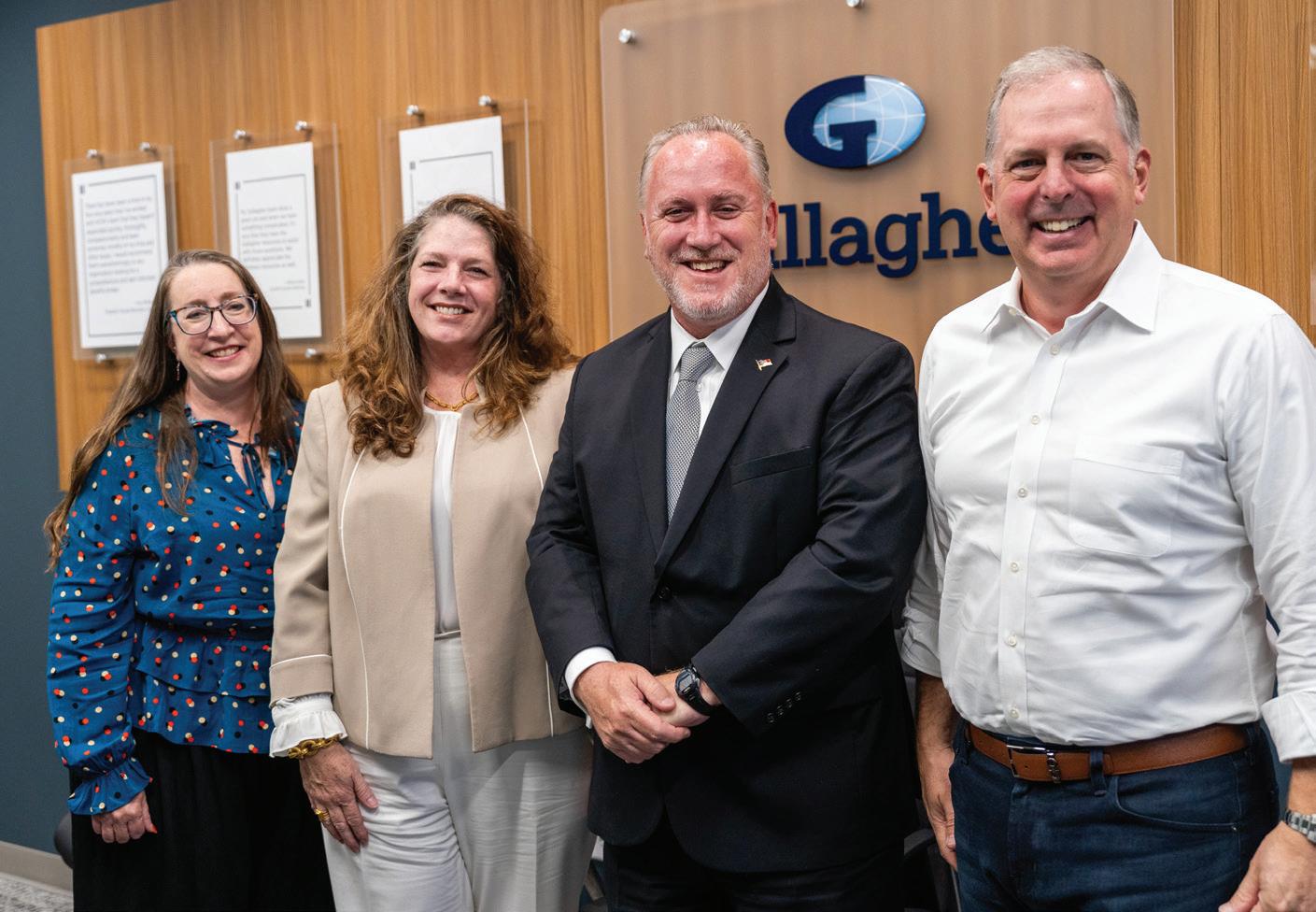
LOYACK: North Carolina has been on a fantastic run the past five years or so. There have been major economic announcements statewide. And it doesn’t seem to be slowing: Reckitt recently announced it’s investing more than $145 million to build a factory in Wilson, where it will produce the over-the-counter medicine Mucinex and create 289 jobs. We’ve seen rapid growth in the Charlotte and Triangle regions the past two decades. And while they’re still growing, growth is happening outside those regions more often. The Piedmont Triad has been busy. And there’s the BioPharma Crescent, a growing concentration of manufacturers that stretches from Chatham County to Pitt County. There’s more good news — the state’s significant net immigration. More people are moving here every day. Some states, such as Wisconsin and Minnesota, have zero population growth, so they’re faced with a bigger workforce challenge. We must connect new residents with job opportunities. Many aren’t aware of what’s available. The organizations that we work for are getting more creative about advertising jobs. Business are trying everything and
anything to get the word out about their job opportunities. Morinaga America Foods, for example, is using interstate billboards to find workers for its candy factory in Mebane.
HARRIS: Most people moving to North Carolina are coming with a company or coming to retire and start a business, the entrepreneurial route. But there are untapped populations of people already here looking for a job. Some are finishing community college or leaving prison. They may be coming out of retirement, or they may be moms returning to work after raising their children. Many don’t know where to turn, because they’ve been out of the job market for an extended time. Those are the populations we look at first. We want to tell them about jobs and training opportunities. But they’re not in the usual places where you find job-seekers. Reaching them is a challenge.
KELLY: Our industry looks far forward — 10, 20 or more years — to predict workforce needs and patient population. Now is the time to build capacity. There’s a long run up to meeting the needs of the population. We take particular note of North Carolina’s shifting demographics. There were five working adults for every person age 65 or older in 2000. That’s expected to drop to two working adults by 2030. That’s not a good projection
for any industry, but it’s especially bad for ours. Older people usually need more health care, so we need the workforce to support them. We need to innovate health care delivery and attract workers. The health care industry isn’t only nurses and doctors. It’s comprised of many jobs. You can be a chef in food service, handle information-technology needs or work in insurance. And if you wanted to be a nurse but didn’t get into nursing school, you can still work in many other clinical fields with training from a community college or university.
WOODY: The market has shifted. It was employee driven immediately post-pandemic. Businesses were fighting for every applicant, even though many lacked needed qualifications. They were forced to pay big signing bonuses, and pay ranges went out of whack. Some of that is being corrected as the market settles into more of an equilibrium. There’s still a lack of qualified applicants, but there are fewer job openings. So, employers are taking different approaches. They’re focused on the complete person, along with well-being and engagement. They realize they need the right people to be successful. North Carolina health care, for example, has a sterling reputation, but it needs the right people to maintain it. Businesses are investing more in professional development, career pathing and other employee support.
Many new workers are replacing seasoned individuals, so they’ve yet to acquire all needed skills. Employers are investing in programs to bring them up to speed. Many applicants need additional training to qualify for jobs — maybe not the one that they’re applying for now, but the one we want them to have in the future.
LOYACK: Apprenticeships have a storied history, all the way back to the National Apprenticeship Act of 1937. But for a long time, they were seen as something only associated with the trades. If you wanted to be a plumber, electrician or mason, as examples, then you started as an apprentice. That was the path. Apprenticeships continue today, though they’re finding homes in a wider spectrum of industries. If you’re a biotech company in the Triangle or a hospital somewhere between Murphy and Manteo, as examples, you need an effective HVAC system. And it’s not something a local business can service or repair. You need dedicated employees who have been trained within your business’s four walls to understand how your HVAC operates. So, more businesses are eyeing the apprentice approach, along with other models, because of the skilled workforce shortage. The national debate over student debt is shining a light on it, too. People want options. Many businesses use N.C. Department of Commerce’s job training and the community college system’s customized training, but they want to be more involved in preparing employees. Each has a specific curriculum to introduce, and apprenticeships are an employer-controlled vehicle that drives
talent development. Apprenticeship is an earn while you learn model. It not only integrates education, whether it be the community college system or private, but gives individuals the training that businesses want them to have and something they may not get in the theoretical space of traditional schooling. We’re considering a form of apprenticeships to address the shortage of nurses — as many as 25,000 by 2030. Several community colleges are already working on programs. A high school student could learn about nursing in an apprenticeship program, walking away with a certificate or as a certified nursing assistant. Then they could consider attending a registered nurse program at a four-year university. If they work for the private sector, why wouldn’t they work for the public sector? We see their impact they’re making across the state. I recently participated in a panel discussion with Dr. John Hauser, Gaston College president. He talked about Apprenticeship 321, which prepares students for careers in advanced manufacturing, industrial maintenance and health care. Nine of its graduates became homeowners after working four years. These programs are addressing issues beyond workplace skills such as economic mobility.
KELLY: You can work your entire career in healthcare; there are many ways to ebb and flow within the industry. I spend a lot of time with folks who understand that you must start early to interest someone in a health care career. There are ways of capturing someone in their teens who wants to make some extra income. And with a few baby steps, they can work in a hospital as a teenager. Some hospitals are doing innovative things such as allowing people to work and attend school; they’re paying for tuition while learning highly skilled
tasks and earning certificates or an associate or four-year degree. Working while going to school not only gets them where they want to go, but it also allows them to explore other career possibilities in health care. They may be unsure if they want to be a pharmacist, phlebotomist or radiologic technologist, but they can find out by starting as a CNA, observing firsthand what different jobs entail. Apprenticeships allow that to happen and for hospitals to help underwrite some of the associated costs, either directly or indirectly, through wages. We recently started a campaign aimed at getting teenagers interested in health care careers. It’s called I do care. Its website — IdocareNC.org — offers a county-by-county listing of what hospitals and community colleges offer in regards to employment and training. The goal is making connections, so folks understand what scholarship opportunities are available and what some of the education dollars, such as federal programs, are available. Even though those federal funds may not be specific to health care, many can be used to get an associate degree or certification to pursue a health care career. We did a social media campaign that garnered more than 3 million impressions over the past month. We’re excited about that, and we’re going to continue it.
WOODY: Nothing is simple as it once was. Every position requires a heightened level of skills. Apprenticeship programs for the trades highlight that. You need a certain amount of seat time to work with plumbing or HVAC. But many jobs outside the trades have the same requirement. And as you see a smaller pool of qualified applicants for any one job, you realize that hiring them away from competitors is expensive. The alternative is finding people who
might eventually fit the role. Enroll them in an apprenticeship or mentor program and get them where you need them to be. It requires an investment, but it also provides a reward. If you can instill your business’s purpose, mission and culture, then make them feel happy, included and recognized along the way, they are more likely to stick around long term, giving your business a big payoff.
HARRIS: Transitional skills are important, too. Fidelity announced it was expanding its customer relations manager positions, adding about 500 jobs in Durham and Charlotte, during COVID-19 pandemic. At the same time, hospitality workers were losing their jobs; hotels, restaurants and other

businesses in that industry were closing because of stay-at-home orders and travel restrictions. Who knows customer service better than hospitality workers? We took many of them and said you can keep working for $8 an hour plus tips, or we can put you into a job that might take some short term on-the-job training. But it’s a professional career that you can grow into. We like to find

what a job-seeker thinks about. It’s always good to ask what they think about doing something different, then use federal workforce programs to help with wage and training reimbursement to the employer to upskill people. There are many of these federal programs. Finding the right one is a case-bycase basis. Some of it fits with training offered by community colleges.


WOODY: What employees value varies based on the stage of their career. The 23-year-old recent graduate wants to know about working from home, bringing a dog to the office and how much feedback is provided. Older employees usually care more about health care and retirement. If a business is going to invest in career and professional development of its employees, it wants them to stick around. So, they need to be careful, thoughtful and intentional in the rewards offered. Most people want benefits, help with retirement and some time off to strike a work-life balance. They want to know that they’re doing a good job. Everyone wants to be paid fairly. It doesn’t have to be the highest rate, but it needs to be fair. It’s expensive to live in the state’s metropolitan centers. Remote work allows employees to live where it’s less expensive. Google, Amazon and other large companies called employees back to the office following the pandemic. While that surely makes owners of commercial office space happy, it has caused concern within segments of the population. Some people need work-athome flexibility to meet family, childcare or parenting needs. Businesses without a remote work option are missing out on those employees. Family, parental, maternity and paternity leave programs are important. We stress emotional well-being of employees, but there aren’t enough well-being care providers in the state to meet demand. So, we lean on virtual care and other professionals. There’s more focus on benefits as part of a reward plan. People want to make sure benefits are good wherever they choose to work. While the core health plans haven’t changed much, their costs
have escalated. Employers are focused on managing them. The more money they spend on those, the less they have for wage increases, additional time off or retirement contributions.
KELLY: Bedside care is one job that cannot be done remotely. While there’s a lot of innovation with telemedicine, remote monitoring and robotic care, there’s still a human element that will always accompany hospital-based care, which is what you want. You go to a hospital for hands-on care that will get you through your event, whether it’s happy, such as a birth, or filled with distress such as an illness or injury. Hands-on care is what we do best, but we know the work around it is changing radically. Clinical shifts traditionally have been 12 hours. One way the health care industry is adapting to a changing workforce is examining the 12-hour shift and thinking about how shift work could be done differently. And while a workweek consisting of three or four 12-hour shifts may be needed in most clinical settings, there are opportunities in health care that aren’t 12-hour shifts. One more top concern is child care access. It drives decision making by employees, especially those living in rural regions. It becomes a Catch-22. Health care availability makes rural regions attractive to relocating businesses and startups. But you need child care to have enough health care workers. It’s a codependent relationship. If you don’t have both, it’s difficult for a business to locate or relocate there. Investing in both is an important economic pillar for rural counties. North Carolina has the country’s second largest rural population. We must create the right environment, so businesses want to be there for those residents.

: The major employer that is most often overlooked is state government. Many benefits, such as signing bonuses, don’t apply to its jobs. Many state employees are based in Raleigh. Wake County’s average annual private-sector wage is almost $75,000. Many state employees aren’t paid at that level, but they still must pay for parking, lunch and other things associated with work. That’s becoming harder to address. One thing that works in favor of state agencies is many employees are mission driven. They love the work. It’s often not a question of will this job make me rich, but will it be fulfilling. We tap into retirees and people beginning their career, times when they might not need to earn their greatest potential. While that helps, challenges remain. The N.C. Division of Motor Vehicles, for example, has shut down three centers, the latest in Lillington, because it can’t find workers. That’s tough.
KELLY: The country is at an inflection point about the nature of work — what it means, why we do it and what we do. It’s important for every industry to give people a reason to work. We have a generational shift around how people approach work. In our parents’
and grandparents’ generations, you graduated high school and immediately went into a trade, blue collar or white collar. If yours didn’t require a fouryear degree, then you were expected to be working at age 18 and continue to work that same job until you retired. Most people no longer accept the notion of one career. We move around more than ever and expect to work multiple jobs over our lifetime. Entrepreneurship has become a side hustle. The gig economy exists in every trade and every field. I don’t know that we could have predicted that 20 years ago.
WOODY: Many people relocate to live and raise their family in North Carolina. That brings talent, which often
arrives ready to work. They want to work. They’re ready to engage, but they aren’t sure where. They want to know if they can make a career from a job. They need a track to run on. We must help people find their track, get them where they want to be. It’s good for everyone.
LOYACK: There are transformational changes underway. The workforce shortage has become such a challenge that we are reaching into communities that were ignored in the past. The community college system rolled out a pilot program for people with intellectual and developmental disabilities at two community colleges — Brunswick and Catawba Valley —
with seed funding from the General Assembly. It ran for two years, enrolling about 200 students. At the end, 55% of them had job offers. The program is being rolled out to 15 colleges, because of its initial success. We’re looking to prepare members of this community for work, whether with a local small business or large manufacturer. They traditionally haven’t been supported. The system is working with other communities, too.
About 5,000 incarcerated individuals received training last year, and about 1,000 of them walked away with some high school equivalency education or certification. We’re getting creative like we never have done before. It makes sense. ■










Chatham County is experiencing a remarkable transformation, offering a compelling example of modern, sustainable growth while using intentional planning to maintain its unique charm and reputable quality of life. Equidistant to North Carolina beaches and mountains and near the Triangle’s urban core and airport, Chatham County offers accessibility without density and a business-friendly environment, contributing to its high growth potential.
Well-located in Chatham County, Chatham Park, MOSAIC and Northwood Landing are creating a balanced lifestyle for residents and employees of Pittsboro with 8,500 acres of commercial, residential and leisure opportunities.
Chatham Park is establishing a whole new kind of master-planned live-work-play-learn community – crafting a place where everything is within reach. MOSAIC is Chatham Park’s first entertainment and lifestyle mixed-use destination, and Northwood Landing includes apartments, grocery, retail, services, dining and recreation options.
LIVE: Chatham Park offers a robust blend of residential offerings to align with any life stage or lifestyle. Residential neighborhoods, like Vineyards and Encore by David Weekley, feature townhomes, cottages, and single-family and active adult residences while The Guild at MOSAIC and Medley at Northwood Landing apartment communities deliver direct access to dining, shopping, services and transit stops. Storyliving by Disney™ has selected Chatham Park as a future community destination.
WORK: Small businesses, large companies, entrepreneurs and healthcare providers find their place at Chatham Park. Innovation is at the forefront with the 79°West Innovation Hub at MOSAIC, with coworking, co-warehousing, private offices and events space, and the Innovation District, the future home of medical and corporate campuses, including UNC Health and technology-based businesses. Chatham Park’s Commerce Center includes light industrial flex space.
PLAY: Chatham Park offers 30 miles of trails and 600 acres of parks and open space, including the Knight Farm Community Park, Wade Barber Park and other well-positioned pocket parks. Paddles, a swim and pickleball club, and a soon-to-open full-service Chatham Park YMCA provide active lifestyle opportunities for people of all ages. The Chatham community delights in MOSAIC’s event lawn, activated with concerts, movies, markets and fitness throughout the year, and visitors stay at Hampton Inn & Suites, Pittsboro’s first business hotel.
LEARN: From childhood education at Amazing Explorers Academy to Thales Academy and a forthcoming public elementary school, opportunities to learn abound in Chatham Park. UNC-Chapel Hill’s Innovate Carolina and local businesses provide innovative programming for professionals at MOSAIC’s 79°West Innovation Hub.
SUSTAIN: Chatham Park sets the bar in environmental sensitivity with water and energy conservation and its EcoSelect Plus Program. From reclaimed water treatment systems and LEED certified buildings to a solar farm and bee pollinator stations, the community’s sustainability efforts positively impact the environment.
Opportunity in Chatham Park is right here, right now, with much more on the way – making it a desirable location to live, work, play and learn. Visit Chatham County and discover all of its opportunities to thrive.
chathampark.com – mosaicatchathampark.com – northwoodlanding.com
Chatham County's three major economic development projects — Chatham Park, Chatham-Siler City Advanced Manufacturing Site and Triangle Innovation Point — are transforming its town along with the region and state.







Chatham County is at North Carolina’s heart. Workforce, shovel-ready sites and a business-friendly approach, along with some geography, put it there.
CTI Systems assembles electronics for customers, including SpaceX and Amazon, in the automotive, defense, medical and telecommunications industries. About 70 people work at its 200,000-square-foot plant in the southern Chatham County community of Goldston, the less than 1-squaremile town where fiddle-wielding country musician Charlie Daniels attended high school.
Ryan Gladieux was named CTI’s CEO last year, closing his 25-year career in the plastics packaging industry. But his job description hasn’t been the only change since then. “We’ve invested about $1 million in the past 18 months, specifically on a
new roof and new machinery,” he says. “We also improved the inside offices and conference rooms. We launched a social media campaign, and our followers have gone from 300 to 1,100. And we revamped our website to make it more customer-friendly.”
CTI employees commute from Sanford, Pittsboro, Siler City and Raleigh’s southern suburbs. “We love the small-town feel [of Goldston], and the people here are proud,” Gladieux says. “We aim to double sales in the coming years, launch new products, and really transform this building and land into a place where people would beg to work.”




Chatham County is at the center of many success stories such as CTI, literally and figuratively. The U.S. Geological Survey determined North Carolina’s geographic center is near Gulf, about 15 miles southwest of the county seat — Pittsboro. “We are grateful for our fantastic geography that puts us in the middle of the Triangle and Triad,” says Chatham Economic Development President Michael Smith, who notes the proximity to Raleigh-Durham International Airport, where more than 350 flights head to destinations near and far daily, and Research Triangle Park, home to cutting-edge companies. “One of the things that’s fascinating is that if you’re standing in the northeast corner of Chatham County, you literally are in walking distance to RTP,” he says.
Chatham Economic Development Business Development Manager Jack Pendergraph says it wasn’t long ago that driving to the state’s capital seemed like a journey. “Now, they’re
right around the corner,” he says. “Travel time from downtown Raleigh to Pittsboro is about 35 minutes. A 45-minute drive in any direction enables you to do all kinds of things, like see a show or go to a ballgame.”
Chatham County is home to one of the state’s largest economic development projects, VinFast’s $4 billion electric car factory, which is expected to open in 2028 and create 7,500 jobs. Landing it took teamwork, especially locally. “TriRiver Water is the regional utility provider in Sanford, and they have the water and sewer connectivity to areas outside Sanford, like Holly Springs and Fuquay-Varina,” Smith says. “We’re all connected in this part of North Carolina, and we all understand that these businesses have people who live and work in multiple communities. A win for one is a win for all, and we certainly believe that here. We have business-friendly elected officials here in Chatham County that have provided great support for our organization and
the companies that are here.”
Local officials prioritize strategic planning, affordable housing and infrastructure – roads, water and sewer – says Kirk Bradley, president, CEO and chair of real-estate developer Lee-Moore Capital, which is behind several mixed-use developments in Chatham County. “One example, TriRiver Water, has created a scalable enterprise,” he says. “So, we’re positioned for regional expansion over the next 20-plus years. We’re equipped with enough power generation to support data centers and AI. Chatham has the highest growth potential in the state.”
Chatham County’s businesses, utilities and workers routinely cross its boundaries. “Chatham County has multiple addresses,” Smith says. “Some overlap into Chapel Hill and Cary. And the water-sewer lines for Triangle Innovation Point West [industrial park] and VinFast show we have excellent relationships with our neighbors.”


Earlier this year, Jacksonville, Florida-based housing component manufacturer Innovative Construction Group announced it’s building a factory on 46 acres at the ChathamSiler City Advanced Manufacturing Site. The almost $40 million investment is expected to create 157 jobs during the next five years. Their average annual salary will be $52,949, more than the county’s current average of $50,302.
CAM, which stretches across 1,350 acres, also is home to Wolfspeed, which announced a $5 billion investment in 2022. Its factory – John Palmour Manufacturing Center for Silicon Carbide – will be the world’s



largest and make materials for the automotive, telecommunications and other industries. Expected to create 1,800 jobs by 2030, it began growing silicon carbide crystals in June. “I think it’s another example of a competitive project that was looking at a major metro area in another state and selected us,” Smith says. “It’s another testament to our location and workforce, and the fact that they’re in homebuilding fits in with all our developments to come.”
A growing population is vital to a growing workforce. The N.C. Office of State Budget and Management says Chatham Countty had about 81,000 residents in 2023, up from about 66,000 a decade before. Two sources will continue adding to it. “First

is nearby Fort Liberty, which has 8,000 exiting military folks every year,” Smith says. “Second, the fouryear colleges have 40,000 graduates every year, and a high percentage of them, at this stage, are interested in staying in the region. You have university students and military folks, who may be from other parts of the state, and they realize this is a great place to raise a family and get a job. They want to stay.”
Smith says the county’s abundance of industries, thanks to quick access from US-64 and interstate 40, draw workers from a 10-county region.
“Basically from Guilford to Johnston [counties], we’re in the middle,” he says. “We have a compelling story when it comes to workforce.”

Central Carolina Community College is expanding its offerings, training works for advanced-manufacturing jobs, including those at Wolfspeed's John Palmour Manufacturing Center for Silicon Carbide at ChathamSiler City Advanced Manufacturing Site.



Central Carolina Community College has three campuses – Pittsboro, Sanford and Siler City. Its 22-acre E. Eugene Moore Manufacturing and Biotech Solutions Center in Pittsboro showed off its new Industry Skills Training Lab to business partners at an open house in June. “[It]is an opportunity not only for CCCC to expand our ability to respond to the demand for a highly skilled workforce, but it is a regional resource to provide workforce solutions in advanced manufacturing,” says CCCC Vice President of Workforce Development Margaret Roberton. CCCC reports there are about 104,000 biotechnology and advanced-manufacturing jobs in the region, and it expects about 20,000 more, based on recent economic
development announcements, including VinFast and Wolfspeed.
CCCC hosted its annual National Manufacturing Day in October, one more effort to address workforce needs. Roberton says more than 30 companies participated in last year’s showcase, which attracted more than 800 attendees, including 500 students. “CCCC works closely with all of our local high school partners to support Career and College Promise pathways,” she says. “We have robust [Career and Technical Education] programs that prepare students for a variety of technical paths ranging from biotechnology to robotic welding. We have several new high school CTE opportunities this year, including BioWork in Lee County and advanced manufacturing in Chatham County.”
■ 350 acres designed for manufacturing, life science and distribution facilities
■ Lot sizes range from 5 acres – 350 acres, flexible to suit needs
■ 1 mile from US 1; 12 miles from I-540
■ All due diligence complete
■ All utilities in place
■ Existing corporate neighbors include VinFast, FedEx Ground
■ Skilled workforce of 1.5 M from two major metro areas
■ Easy access to RTP and RDU


CCCC isn’t stopping. It's expanding to meet developing workforce needs. Its CDL program, for example, has been underway for a year, and industrial maintenance classes started this fall. “Renovation plans for the 10,000square-foot biotechnology building are moving forward with construction targeted to begin in early 2025,” Roberton says. “This effort is parallel with the design work on Phase One of the 180,000-square-foot manufacturing building with construction beginning in the next fiscal year. Phase One is focused on the specialty training environments supporting customizedand short-term training with industrial systems, quality and robotics labs as well as a new welding lab, which will be utilized by the [Caterpillar Youth Apprenticeship] students.”


Addressing workforce needs is the start of creating a welcoming environment for businesses, Bradley says. “From school choice for K-12 to free community college, Chatham is getting its students career-ready,” he says. “Our Career and Technical Education pathway is on full display with a 50% participation rate. Businesses partner with our educational systems, which will keep and attract top talent.” But efforts go deeper. Site availability and business-friendly policies also attract businesses to Chatham County.
“Close proximity to the Triangle’s urban core – but without the density

and accompanying challenges –lures industry and residents alike,” he says.
Assistance continues once a business arrives. Pendergraph leads Chatham County’s existing industry program. “The program was formally started about a year-and-a-half ago,” he says. “We have major companies, such as VinFast and Wolfspeed and FedEx, and wanted to give them the ability to grow, so we hosted a number of career fairs. Wolfspeed actually has a written commitment that 7% of their contracting has to go to locally owned small and diverse businesses. So, they hosted their own

‘supplier days,’ and we served as the conduit on the county side.”
Not every big business in Chatham County is urban. Agricultural food producer and processer Mountaire Farms employs 10,000 at locations across five states, including North Carolina, where it has a processing plant and hatcheries near Siler City. Part of its mission, the website says, is to be the No. 1 veteran and first responder employer in the state through its Hiring Our Heroes Program.
Prospective businesses aren’t the only ones eyeing Chatham County. “In 2023, tourism [spending] rose 5.1% year-over-year, and visitors contributed $79.59 million to Chatham County’s tax base,” Bradley says. “The county just welcomed its first business class hotel [Hampton Inn & Suites], which will accommodate our growing visitor base. Come see it. It’s not your mother's or father’s Chatham County. It’s a different place, and you should see it with your own eyes, because it’s different and even better than you think.” ■
— Kathy Blake is a writer from eastern North Carolina.
Pre-Construction
Design/Build
Conceptual/ProjectBudgeting












Growing Chatham Park gives its residents all they need — work, play and live — in one place.
Chatham Park began with a 1,700-acre purchase in 2006. “That was going to be the project,” says Vanessa Jenkins, senior executive vice president of Preston Development, the Cary-based company behind the mixed-use development between Raleigh and Pittsboro. Its residential portfolio includes projects in Raleigh, Cary, Holly Springs, Fuquay-Varina, Knightdale, Morrisville, New Bern and Wilmington. “Then came the downturn in 2008,” she says. “We continued to purchase land that abutted the original piece, and a large parcel became available north of the [U.S. 64] bypass. The land mass of approximately 8,500 acres evolved from there, and we have 27,000 residential units and 22 million square
feet of non-residential space.”
Chatham Park is work, live and play from the ground up. Its design rests on five pillars: innovation, healthy balance, connectivity, quality design and stewardship. Jenkins says they’ve guided the incorporation of such things as green infrastructure, a water recovery center that handles stormwater and disposes of graywater by creating a source for irrigation and cooling of manufacturing equipment, a 46-acre solar farm, bee program and the ecoSelect Plus program that enhances energy efficiency in homes. Situated on the Haw River’s bank and Jordan Lake’s shore, its trails, parks and open-space buffers cover more than 2,000 acres. “[Designers committed that] every resident will be no more than a five-minute walk to
some type of park, greenway, trail or amenity,” she says.
More than 750 of Chatham Park’s homesites are occupied. Supporting them are office and retail spaces; entertainment venues; parks, recreation and open space; 30 miles of trails; a daycare and kindergarten through seventh-grade school; health care; and a recently opened the Hampton Inn & Suites. A 35,000-square-foot YMCA is expected to open in the spring. “Sales across all housing types have been good and continue to be strong,” Jenkins says. “We’re very technology forward, with innovation through our homes and through the actual design of the community, and we’re trying to spotlight that for people to see. It is a really cool ecosystem to be in.”
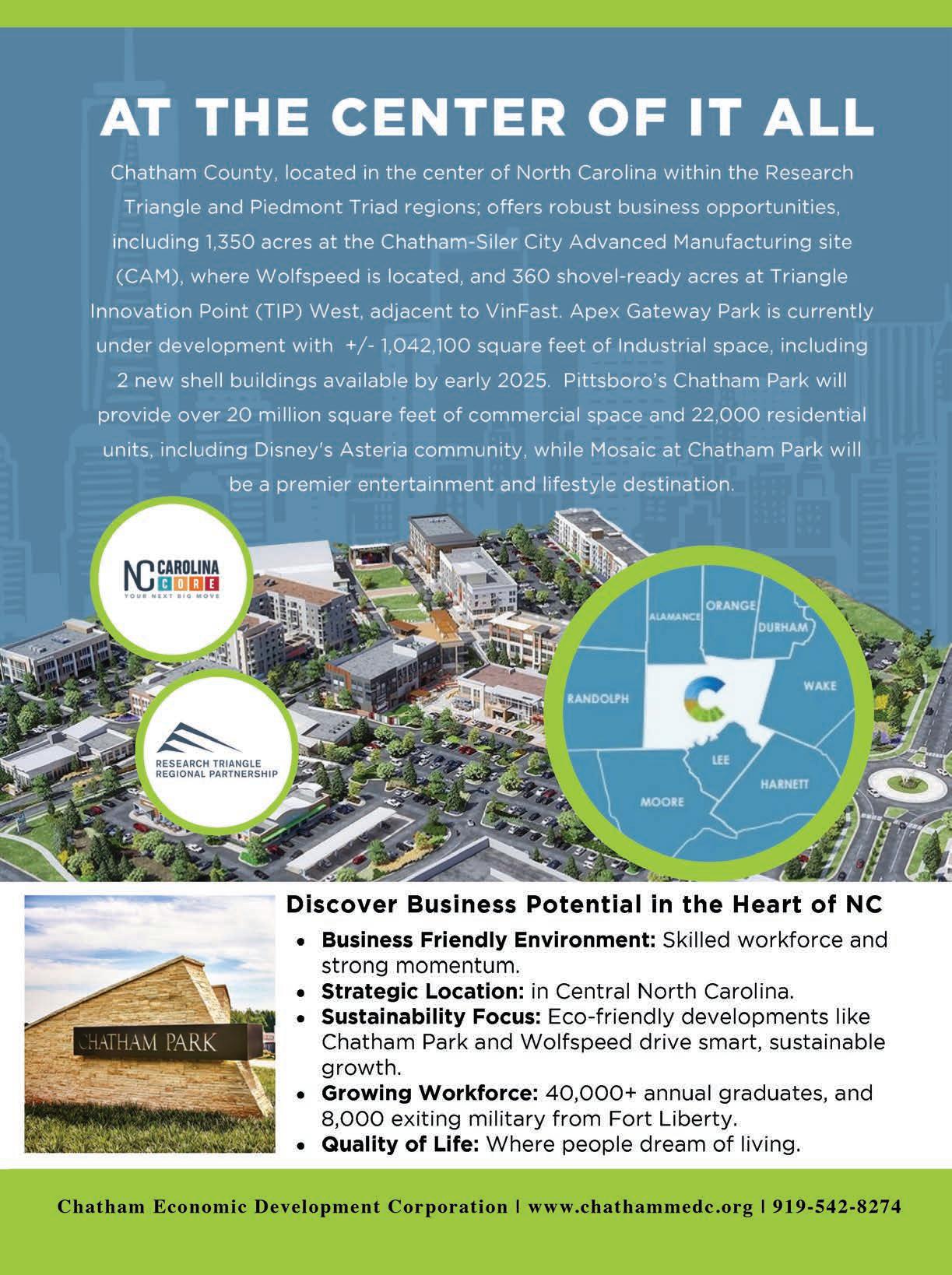
A study by NC State University economist Michael Walden found that a completed Chatham Park would create more than 115,000 jobs and a $154 billion statewide economic impact during the next 40 years. Chatham County has added more than 3,000 residents over the past four years, and more are expected as companies arrive or expand and bring jobs, including electric vehicle maker VinFast and silicon-carbide manufacturer Wolfspeed. Chatham Economic Development President Michael Smith says about 120 residents move to the region every day. “Any large project we have, Chatham Park is part of the discussion every single time,” he says. For families, seniors and county residents employed at Chatham County’s incoming industries and megasites, it’s a one-stop-fits-all.
Chatham Park is spurring building adjacent to its boundaries. Lee-Moore Capital is constructing two multiuse projects – Northwood Landing and Medley at Northwood Landing apartments – across U.S. 15-501 from the original Chatham Park site. Jenkins says those parcels are being developed to “seamlessly be part

of the overall Chatham Park.” The Sanford-based real-estate developer is working inside Chatham Park, too. MOSAIC, a 44-acre mixeduse development, is tagged as the gateway to Chatham Park. Walkable and an urban destination, it blends retail – restaurants, taproom, coffee shop; workspace – podcast room, co-working area, office buildings; and a family commons for outdoor events. It also has a convenience store and gas station, UNC Urgent Care, the Hampton, one- and twobedroom condominiums and a 1-mile walking path. Bordering U.S. 15-501, it includes David Weekley Homes’ Encore homes, which are priced in the $400,000s and targeted at people age 55 and older.
Kirk Bradley, Lee-Moore Capital president, CEO and chair, says a mix of housing types – single-family, condos and apartments – at a variety of price points are in the works. “Workforce housing is a priority to ensure that teachers, police and other essential workers can live where they work,” he says. “Leaders are intentional about new development beyond bricks and mortar – designing with the community in mind [and]
offering a blend of green spaces, cultural venues, and lifestyle amenities alongside daily necessities such as grocery, salons, pet care, services, dining and shopping.”
Chatham Park also is getting a bit of Disney magic. Walt Disney Co.’s Storyliving by Disney announced Asteria, a planned community built with Disney Imagineering and staffed by Disney cast members, last year. It’ll have almost 4,000 residences — including single family, multifamily and senior living — a clubhouse, wellness center, community garden and extensive system of trails. Property sales are expected to begin in 2027.
The first Storyliving by Disney community, Cotino, is under construction in Rancho Mirage, California. “When Disney was asked where their second community was going to be, they said they were looking for a place in America where people dream of living,” Smith says. “And Disney selected Pittsboro in Chatham County. Every day, we’re adding to the dream, and we keep dreaming. We’re not going to stop dreaming.” ■
— Kathy Blake is a writer from eastern North Carolina.

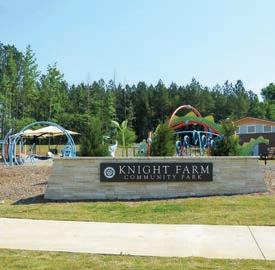




BY DAVID MILDENBERG
Only 45 miles separate Wilson and Raleigh, but their trajectories are distinct. While Wake County’s population nearly tripled since 1990, Wilson County advanced 19%, and declined during the 2010s. Median family income in Wilson is about half as much as in tech and government powerhouse Wake.
It’s been a bumpy road for Wilson, which is famous in North Carolina for its barbecue restaurants, former tobacco warehouses and Truist predecessor BB&T.
But the county’s economic fortunes are turning, which local chamber chief Ryan Simons calls “an overnight success that has been decades in the making.”
In early October, Johnson & Johnson said it would invest $2 billion near Wilson to manufacture medicines. Janssen Biotech, a subsidiary of the world’s largest healthcare products company, expects to employ 420 people by 2031 with salaries averaging almost $109,000, J&J is in line for about $30 million in incentives from the state and $54 million from the city of Wilson and Wilson County.

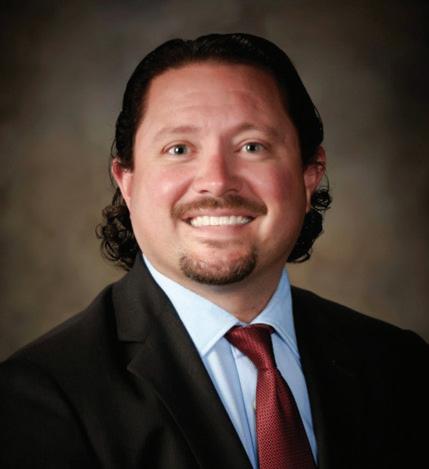
The record investment for the area continues a series of expansions that stem from decades of groundwork, notes Jennifer Lantz, who has led the Wilson County Economic Development Corp. since 1989.
County officials started Wilson Corporate Park in the early 1990s and it now will be home to operations of five major pharma operations: Merck, Fresenius Kabi, Purdue, Reckitt and J&J. While J&J is building a factory, Reckitt plans to make Mucinex and other products at a site formerly owned by Novartis.
“We’re very much patient about who we will put in the park,” Lantz says.
Economic developers often talk about collaboration, but Lantz says the J&J deal was more than a cliché. She cites state lawmakers for approving construction of a Wilson Community


College worker-training site and the Golden LEAF Foundation for pledging $13 million for equipment for the college building. She also credits city and state officials for approving more than $80 million in incentives, mostly tied to J&J meeting its job and investment targets.
“The new biologics training center is a big reason J&J chose to come to Wilson,” she says. “Every life sciences company needs to know that we are doing things to ensure that their workforce will be here not just today, but in five to 10 years.”
The NC Bioworks program affiliated with community colleges in Pitt, Wilson and Johnston counties enables industry entrants to secure enough training, within a few months, for an entry-level position paying $80,000 a year, Lantz says.
Wilson is also showing new energy in its downtown area after apartments and retail stores replaced the former BB&T headquarters buildings. The bank shifted headquarters to Winston-Salem in 1994, then headed to Charlotte during the 2019 merger creating Truist.
A downtown YMCA opened two years ago, while a baseball stadium to house a Milwaukee Brewers-affiliated minor-league team should debut in April.
Truist still employs about 2,000 workers in Wilson, while the city’s 1,900-worker Bridgestone tire factory has received massive investment in recent years from its Japanese parent company.


“Truist has been respectful to its roots,” says Simons, who has led the chamber since 2013. “They’ve been joined by some visionary leaders in city and area county governments who wanted to be partners to make it happen.
“I would be surprised if you are going to find the level of collaboration between local government, nonprofits and the business/industry sector as you will find in Wilson. We are all going in the same direction.” ■

